|
|
|
|
|
|
SEVEN LUCKY GODS MENU
Intro Page
Benzaiten
Bishamonten 
Daikokuten
Ebisu
Fukurokuju
Hotei
Jurōjin
Related BISHAMON Pages
Four Heavenly Kings (Shitennō)
Twelve Protectors (Jūniten)
|
|
|
BISHAMON SPELLINGS
|
|
|
Jp = Bishamon 毘沙門
Jp = Bishamonten 毘沙門天
Jp = Bishamontennō 毘沙門天王
Jp = Tobatsu Bishamon 兜跋毘沙門天
Jp = Tōhachi Bishamon 刀八毘沙門天
Jp = Shōteki Bishamon 勝敵毘沙門
Skt. = वैश्रवण, Pali = वेस्सवण
Skt. = Vaiśravaṇa, Pali = Vessavaṇa
Chn. = Píshāmén 毘沙門
Krn. = Bisamun, Pisamun, 비사문천
Vaiśravaṇa = ヴァイシュラヴァナ
Vaiśravaṇa = Kuvera / Kubera
|
|
|
BISHAMON MENU
|
|
|
Main Forms in Japan
Tamonten Statues
Bishamonten Statues
Tobatsu Bishamon
Comparing Iconography
As One of 12 Deva
As a Form of Kannon
Expeller of Illness & Plague
Early Drawings & Paintings
With Wife and Child
Kurama Dera, Bishamon, Kannon
Syncretic Forms & Associations
As One of Seven Lucky Gods
Kubera / Kuvera (Hindu)
Primary / Secondary Sources
|
|
|
BISHAMON MANTRA
|
|
|
おん べいしらまなや そわか
On Beishiramanaya Sowaka

Sanskrit Seed
Pronounced VAI or BEI in Japan
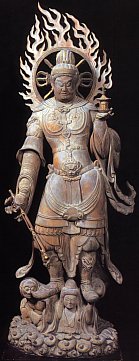
Tobatsu Bishamon, ICP, Heian Era. Wood (Kusu 樟), H 160 cm, Ichiboku Zukuri, Kanzeonji 観世音寺. Fukuoka Pref. Photo from Dazaifu Museum
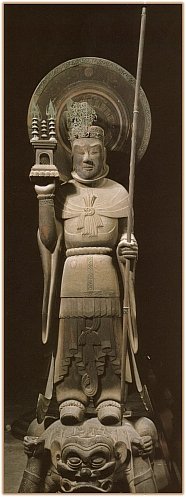
Tamonten (aka Bishamon)
atop a Jyaki Demon. H = 134.2 cm.
7th C., Hōryūji Temple 法隆寺, Nara. Japan's oldest extant statue of Tamonten. Photo: Comprehensive Dictionary of Japan's National
Treasures, 1985, ISBN 4-06-187822-0
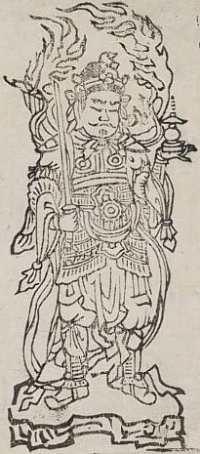
Bishamonten, Print
Heian period, 1162. Photo courtesy Museum of Fine Arts, Boston.
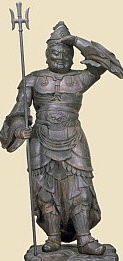
Bishamonten, Wood, H = 176 cm
Protector of Kyoto's Northern Areas
Heian Era, 11-12C, Nat'l Treasure
Kurama Temple 鞍馬寺, Kyoto
|
|
 
BISHAMON, BISHAMONTEN 毘沙門天
God of Treasure, Wealth, & Warriors
Protector of Buddhism, Guardian of the North
Dispenser of Riches, Defender of the Nation, Scourge of
Evil Doers, Healer of Ilness, Commander of the Shitennō
As Tobatsu Bishamon, protects capitals & repels foreign invaders
Origin = India
Vedic deity incorporated into Buddhism
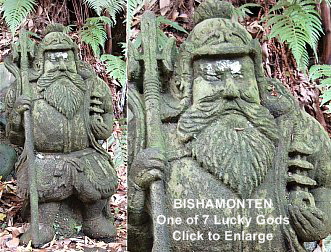
Stone statue in private garden, Kamakura (Japan), early 20th century,
holding his main identifying attribute -- the stupa / pagoda -- in left hand.
The stupa represents the divine treasure house of Buddha's teachings.
ASSOCIATIONSNorth, Winter, Black, Treasure, Centipedes, Faith One of Japan's Seven Lucky GodsOne of Four Heavenly Kings (Shitennō)One of the Tenbu (Deva) & 12 Protectors (Jūniten)One of the Happōten & Jitten (Directional Guardians) One of 33 Kannon Forms & 28 Kannon GuardiansManifestation of Kannon (Buddhist Divinity of Mercy) Protector of Those Who Believe in the Lotus Sutra Linked to Benzai, Daikoku, Kichijōten, Shōgun JizōIdentified with Kuvera / Kubera (Hindu Deity of Weath) Associated Virtue = Dignity
|
SEVEN VIRTUES
Japan's Seven Lucky Gods are a popular grouping of deities
that appeared from the 15th century onward. The members of
the grouping changed over time, but a standardized set
appeared by the 17th century. In the 17th century, Japanese
monk Tenkai (who died in 1643 and was posthumously named
Jigen Daishi) symbolized each of the seven with an essential
virtue for the Shogun Tokugawa Iemitsu (1623-1650 AD).
The seven virtues are:
- Candour (Ebisu)
- Fortune (Daikokuten)
- Amiability (Benzaiten)
- Magnanimity (Hotei)
- Popularity (Fukurokuju)
- Longevity (Juroujin)
- Dignity (Bishamonten)
References: Flammarion Iconographic Guide - Buddhism
|
OVERVIEW. Male. Defender of the Nation, Guardian of the Dharma (Buddhist Law), and Lord of Wealth and Treasure (hence his inclusion in the Japanese group of Seven Lucky Gods). This armor-clad, weapon-wielding, demon-stomping deity was introduced to Japan in the 6th century AD as one of the four Shitennō (Four Heavenly Kings Protecting the Four Directions), wherein he is known as Tamonten 多聞天, the guardian of the north and protector of the holy places where Buddha expounds the teachings. The Four Kings soon rose to great prominence in rites to safeguard the Japanese nation. In later centuries, however, Tamonten became the object of an independent cult, supplanting the other three in importance. When worshipped independently, he is called Bishamonten (or Bishamon, Bishamon Tennō, Tobatsu Bishamon), but when portrayed among the Shitennō he is called Tamonten.
Bishamon is the god of warriors (but not of war) and prayed to for victory prior to battle. He is also a god of defense against foreign invaders, a deity of healing with the power to save emperors from life-threatening illness and to expel demons of plague (details below), to keep personal enemies at bay
NOTE:
The Azuma Kagami, an official Japanese record of the Kamakura era describing events between 1180 and 1266, says both Minamoto Yoritomo (1147-1199) and his mortal enemy Taira no Kiyomori (1118-1181) prayed to Bishamon for assistance in crushing their enemies in battle. The Minamoto clan eventually defeated the Taira.
, and to reward followers with riches, good fortune, and even children. REFERENCES:
See Konjaku Monogatari, a collection of tales from India, China, and Japan written during the late 11th century to early 12th century. It includes a story of how Bishamon granted a child to a poor monk. For the English translation of the story, see Marian Ury's Tales of Times Now Past. Sixty-Two Stories from a Medieval Japanese Collection. University of California Press, 1979, pages 117-120. Around the 15th century, he was enlisted as one of Japan's Seven Lucky Gods owing to his association with treasure and wealth. He is identified with various other deities, including the Hindu god of wealth Kubera / Kuvera; the Buddhist deity Tobatsu Bishamon (protector of capital cities and dispeller of foreign invaders); the Great Black Warrior of Vedic lore Mahākāla (aka Daikokuten, another member of Japan's Seven Lucky Gods); the goddess of wealth and beauty Kichijōten (his wife in Japanese Buddhist lore); and with various syncretic deities including Sanmen Daikokuten, Tenkawa Benzaiten, Shōgun Jizō, and Sōshin Bishamonten (details below).
|

The stupa is his main identifying attribute.
|
|
ICONOGRAPHY. Bishamonten and Tamonten are almost identical in iconography. Both are nearly always dressed in armor (yoroi 鎧), looking ferocious (funnusō 忿怒相) and standing atop (trampling) one or two demons (jyaki 邪鬼), symbolizing the subjagation of evil. One hand carries a weapon (e.g., halberd, lance, baton) to eliminate evil influences and suppress the enemies of Buddhism. The other holds a treasure pagoda (hōtō 宝塔, 寶塔; Skt. = stupa). The stupa is the deity's main identifying attribute. It represents the divine treasure house of Buddha's teachings and symbolically contains the precious relics (ashes, bones, nail clippings, hair, teeth, etc.) of Buddha's cremated body. Bishamon (Tamon) is both a protector of and dispenser of its bounty -- he shares the pagoda's vast treasures with only "the worthy." Despite their near-identical iconography, Bishamon / Tamon can still be differentiated based on a few rules of thumb (e.g., placement of stupa in right or left hand, type of armor, attendant deities). Such matters are addressed throughout this report.
ORIGINS. Like many Buddhist divinities, Bishamonten traces his origin back to India's Hindu-Buddhist pantheon, where he is known as Vaiśravaṇa (Pāli = Vessavaṇa), transliterated into Chinese as Píshāmén 毘沙門 (Jp. = Bishamon or Beishiramana 吠室羅未拏), and translated as Tamonten 多聞天 (lit. = One Who Hears Much), for he listened eagerly to the Buddha's sermons. Also known as Takutō Tennō 托塔天王 (Chn. = Tuōtǎ tiānwáng), meaning "deva-king who holds a pagoda on his palm." In China, he is considered the king of the north, the protector of earthly treasure, and the commander of the Yasha 夜叉 and Rasetsu 羅刹 (earth spirits and demons). In Chinese mythology, north corresponds to winter and the color black -- thus Bishamonten is also called the Black Warrior (genbu 玄武). <noteNOTE:
Bishamonten and Shitenno iconography is related to the Four Celestial Emblems, a Chinese grouping of four legendary animals (dragon, red bird, tiger, turtle) who guard the four cardinal directions (east, south, west, north). In this latter grouping, the turtle corresponds to north, winter, and black. Indeed, the turtle is known as GENBU, meaning Black Warrior or Dark Warrior. In Japan, the symbolism of the four creatures appears to have merged with and been supplanted by the Shitenno (Four Heavenly Kings). The latter four are the Buddhist guardians of the four directions. For more, please see the Four Celestial Emblems Page, or jump directly to its Tortoise Section. > In China and Japan, he is considered the "Buddhacized" version of the black-skinned Vedic god Kubera. The latter is worshipped in India as the lord of the north, wealth, and treasure, whose name is rendered variously as Kuvera (Pāli), Jambhāla (Skt), 倶吠羅, 倶尾羅, 金毘羅, 金比羅, 拘毘羅, 宮毘羅, or 施財天. <source: DDB; sign in with user name = guest> One of Kubera's epithets is Vaiśravaṇa, for he was said to be the son of the Indian sage Vishrava -- hence the name Vaiśravaṇa. Kubera is the chief of eight army-commanding Yasha (Yaksa) generals who are considered emanations of Vaiśravaṇa or reputed to be his brothers. <Flammarion p. 339> Vaiśravaṇa, like the other Four Heavenly Kings, serves Indra (Jp. = Taishakuten), the lord of the center. Vaiśravaṇa may also be remotely related to the Hindu god Vishnu REFERENCES:
Visnu, Vishnu. The "Preserver." Represents ultimate reality, the all-pervading essence. In Japan, Vishnu appears in numerous forms, including Bichuuten, Mishichijuu, and Ungyou, the latter the closed-mouth Nio Guardian who protects the entrance to the temple. Vishnu's mount is the bird-man deity known in Japan as Karura His wife in Hindu myths is the Buddhist deity known in Japan as Kichijouten or Kudokuten, the goddess of fortune and merit. In Esoteric Buddhism, he appears as a divinity in the outer court of the Taizoukai mandala. He has many different names, including Narayana, Narasimha, and Vasudeva.
See our Vishnu entry, with Sino-Japanese spellings, and links, at VISHNU.
(Jp. = Bichuten 毘紐天), whose wife in Hindu myths is Lakṣmī (Jp. = Kichijōten 吉祥天), goddess of fortune & merit. But in Japan's Buddhist myth, Kichijōten is considered Bishamon's wife.
SCRIPTURAL BASIS. Bishamon-ten is neither a Buddha nor a Bodhisattva. Bishamonten is a deva (a Sanskrit term meaning celestial being or demigod). In China and Japan, deva is written as 天 (pronounced "tiān" in China, "ten" in Japan). When "ten" is added as a suffix to deity names (e.g., Bishamon-ten, Kichijō-ten), it means the deity originated in Hindu myth but in later centuries was adopted into the Buddhist pantheon as a protective god or goddess. In the earliest scriptures he appears as Tamon-ten, the guardian of the north, one of Four Heavenly Kings. These four protect the four cardinal directions (north, south, east, west). Each protects one of the four continents surrounding Mt. Shumisen 須弥山 (Skt. = Mt. Sumeru), the mythical home of the Historical Buddha and other Buddhist deities. These four appear in numerous legends and Mahayana scriptures. In legend, they are said to have assisted at the birth of the Historical Buddha, and during his secret escape from the king (his father) at Kapilavastu, the Four Kings are said to have held up the hooves of his horse (to hide the "sounds" of his escape). One of the earliest texts to introduce the four to Japan is the Goldern Light Sutra 金光明經 (Konkōmyō kyō). Translated into Chinese by Dharmakṣema (Jp. = Donmusen 曇無讖) in the early 5th century, it teaches that rulers who worship this sutra will gain the protection of the Four Kings in safeguarding the nation, benefiting its people, protecting the leaders' palace, defeating enemies, eliminating suffering, and blessing all with peace. The Goldern Light Sutra was one of three scriptures of great importance in old Japan for protecting the country <note
REFERENCES:
The Golden Light Sutra was one of three texts of great influence in old Japan for protecting the nation -- the so-called "three scriptures for protecting the state" are the Golden Light Sutra, the Lotus Sutra, and the Benevolent Kings Sutra (aka Sutra for Humane Kings).
>. In this sutra, Bishamonten (aka Tamonten) is given no precedence over the others -- he appears as an equal member of the group of four, with no special status. But sometime in the 8th and 9th centuries, Bishamonten (aka Tamonten) becomes the commander of the four and the object of his own independent cult of Japanese worship. This "improved status" can be linked to various other early texts. In the popular Lotus Sutra -- translated into Chinese by Kumārajīva 鳩摩羅什 350 - 410 (Jp. = Kumarajū) -- he appears in the Dharani (26th chapter), pledging along with Jikokuten on behalf of all four to protect those who embrace the Lotus Sutra. In the Hōkō Daishōgon Kyō 方廣大莊嚴經, translated into Chinese around 683 AD, the Historical Buddha is offered food by two merchants. When the Four Heavenly Kings hear about this, they offer the Buddha four bowls they have carefully prepared for this exact occasion, which the Buddha miraculously merges into one bowl before eating. In this text, it is Vaiśravaṇa (Tamonten, aka Bishamonten) who offers the first bowl. <NOTE BISHAMON AS PROTECTOR OF TOKHARA, KHOTAN REGION, OXUS RIVER BASIN, CENTRAL ASIA:
Scholar Saroj Kumar Chaudhuri writes: "There is a relief from Gandhara, tentatively dated the third or the fourth century of the Christian era, depicting this scene [of the four bowls being presented to Buddha]. It shows the Buddha with the bowl of Vaisravana in his hand. The three other Heavenly Kings are standing there with bowls in their hands. The interesting thing to note here is the dress of empty-handed Vaisravana. He is dressed in Kushan fashion, whereas the other three are in Indian dress." Quote from Saroj's book
Hindu Gods and Goddesses in Japan. Chaudhuri, Saroj Kumar, page 23. Vedams, 2003, xviii, 184 p, ISBN : 81-7936-009-1. >
But the most probable reason for signaling out Bishamon is the Chinese legend of Tobatsu Bishamon 兜跋毘沙門天. This legend revolves around the Central Asian kingdom known as Toupa / Toupo (Jp. = Tobatsu 兜跋) in the year 742, when Tibet (Jp. = Toban 吐番) attacked Kizil (Jp. = Ansei 安西), which was then the administrative center of western China. To save the situation, the Indian tantric monk Amoghavajra (705-774; Jp. = Fukū 不空; one of the eight Shingon 真言 patriarchs of Esoteric Buddhism) was ordered by the Chinese emperor to pray to Bishamon, who subsequently appeared in the sky and swept away the barbarian forces. Thereafter this deity was known as Toupa P'ishamen in China (Jp. = Tobatsu Bishamon), one who became very popular in Central Asia, China, and Japan. Although scholars still disagree about the exact location of the battle, most believe the word "Toupa" refers to the region in and around Khotan. Because of his reputation for repelling foreign invaders, Toupa P'ishamen images were installed by the Chinese as protectors of regal citadels and capital cities. The Japanese adopted the same legend and practice. See Tobatsu Bishamon below for details and photos.
Bishamon's rank as the most powerful of the four kings is also likely due to his role as king of the north. Says independent scholar Michael D. Gunther: "In Chinese cosmology, still familiar today as 'feng shui 風水,' north is the most dangerous direction, such that dwellings (including the palaces of the Tang and Heian emperors) are built facing in the opposite direction (south). It follows that the Guardian of the North must be the leader of the other directional guardians, and that he must carry the most powerful amulets -- namely, the relics of Buddha's own body -- in order to defend against the malign northern influences. In a practical sense, the north was considered the 'bad' direction for at least two reasons: agriculturally (in the northern hemisphere), the sun is in the south, and therefore a southern exposure is most desirable, and a northern exposure is least desirable (all gardners and farmers know this, even today); and in terms of geopolitics, the Mongol peoples of the north, against whom the Great Wall was built, presented the greatest danger to China throughout much of its history." <end quote by Gunther>

|
MAIN FORMS OF BISHAMON IN JAPAN
|
|
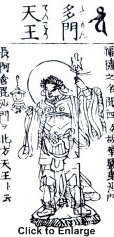
1. Tamonten
FOUR HEAVENLY
KINGS (SHITENNŌ)
|
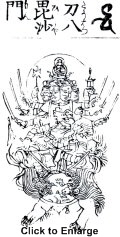
2. Bishamonten
TOBATSU
BISHAMONTEN
|
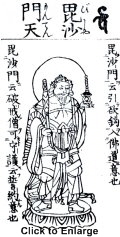
3. Bishamonten
12 DEVA
PROTECTORS
|
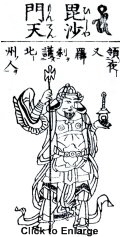
4. Bishamonten
28 KANNON
GUARDIANS
|
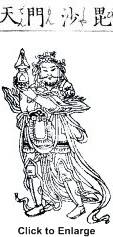
5. Bishamonten
SEVEN
LUCKY GODS
|
- Tamonten, commander of the Four Heavenly Kings; lord of the north; stupa normally (but not always) held in right hand. Jump below to Tamonten photos, or visit our Tamonten page.
- Tobatsu Bishamonten, protector of capital cities, repeller of foreign invaders, lord of the north; stupa in left hand. Commonly shown standing on upturned palms of earth goddess Jiten 地天 (Skt. = Pṛthivī) and flanked by two demons known as Niranba (Skt. = Nīla-vajra) and Biranba (Skt. = Vilambā). Can appear with one head and two arms, but also as a 4-headed 12-armed deity riding a lion, or a 3-headed 10 armed deity atop a lion. Jump below to Tobatsu section.
- One of 12 Deva (Jūniten 十二天), the guardians of the twelve directions in Esoteric Buddhism (Mikkyō 密教); lord of the north, holds stupa in left hand; these 12 appear frequently in mandala paintings (e.g. Taizōkai Mandala, Anchin Mandala, Jūniten Mandala) and other artwork. Jump below to 12 Deva section, or visit our 12 Deva (Jūniten) page.
- One of 28 Guardians (Nijūhachi Bushū 二十八部衆) of the 1,000-Armed Kannon; protector of Buddhist law; stupa in left hand. Jump below to Kannon section, or visit our 28 Guardians page
- One of Japan's Seven Lucky Gods, lord of the north, bringer of wealth and fortune, stupa in left hand or held in both hands. Today he often appears friendly & jolly (as do all members of the seven). Jump below to Seven Lucky Gods section, or visit or Seven Lucky Deities page.
There are other forms as well, many sycretic, which are discussed below. They include:
- Sanmen Daikokuten 三面大黒天 (Three-Headed Daikokuten, Benzaiten & Bishamonten)
- Tenkawa Benzaiten
- Shōgun Jizō and Shōteki Bishamon 勝敵毘沙門 (Mt. Atago)
- Sōshin Bishamonten 雙身毘沙門天 or 双身毘沙門天
Above line drawings from Butsuzō-zu-i 仏像図彙, "Collected Illustrations of Buddhist Images." First published in 1690 (Genroku 元禄 3). Major Japanese dictionary of Buddhist iconography. Hundreds of drawings. Above images from the expanded Meiji-era reprint of the 1783 edition. The expanded version includes Japanese-language commentary by Itō Takemi 伊藤武美 (b. 1927). Last published in 2005. Purchase 2005 reprint here.
|
|

|
TAMONTEN STATUES (STUPA IN RIGHT HAND)
|
|

|
|

Tamonten 多聞天
Another name for Bishamon. King of the North. All-Knowing. Hears all, always listening. Well-versed in Buddha's teachings.
|
|
In Japanese artwork, Tamonten is most commonly shown holding a stupa in his right hand, a weapon in the left, and standing atop a demon (sometimes two). However, his iconography is not rigidly prescribed. He may be shown in Chinese fashion with left hand on hip (Fig. 1); or standing atop earth-goddess Jiten and flanked by two demon attendants (Fig. 4); or holding the pagoda in his left hand (Fig. 5). But such latter depictions of Tamonten are relatively rare in Japan. The Jiten / Demon format, for instance, is predominantly assigned to independently worshipped Tobatsu Bishamon. |
|
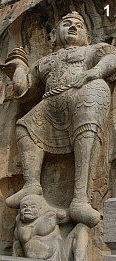 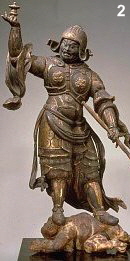 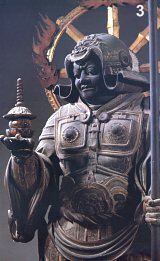 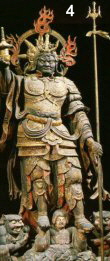 
click any image to enlarge
|
- Tamonten, Fengxian Temple 奉先寺, China, Stone, circa 672-675 AD. Standing atop Jaki demon. Left hand on hip. In China, Bishamon is commonly depicted with left hand on hip, but this iconography was not often used in Japan.
- Tamonten, 13th century, Japan, H = 155.5 cm, Wood, Yosek Zukuri, standing atop Jaki. Stupa in right hand. Photo Nara Nat'l Museum. For various views of this deity, see museum's web site.
- Tamonten, 9th century, Kōfukuji Temple 興福寺 (Nara), Wood, H = 153 cm. Stupa in right hand.
- Tamonten, 9th century, Kōdō 講堂 hall of Tōji Temple 東寺 (Kyoto), Wood, H = 197.9 cm. Held aloft by earth-goddess Jiten, with two demon attendants. Stupa in right hand. Photo from J-magazine 日本の仏像, Issue 3, 2008.
- Tamonten, 12th century, Jōruriji Temple 浄瑠璃寺 (Kyoto), Wood, H = 167 cm. Stupa in left hand.
Photos 3 & 5 from Comprehensive Dictionary of Japan's National Treasures. Kodansha 1985. ISBN 4-06-187822-0.
|
|

|
BISHAMONTEN STATUES (STUPA IN LEFT HAND)
|
|
When portrayed as the independently worshipped Bishamon or Tobatsu Bishamon, he commonly holds the stupa in his left hand. There are exceptions to this iconography (see Fig. 1), but in most cases it helps you correctly identify the deity. The right / left iconograpy was perhaps introduced in the 9th century, but there is no scriptural source for this change. Its introduction may have originated with Japan's esoteric sects. When portrayed as Tobatsu Bishamon, he often wears tight-fitting armor (squeezing in at his waist and dropping down below his knees) and stands atop the hands of earth goddess Jiten, who is flanked by two demons (Fig. 4). Bishamon may also appear without a stupa and instead use his left hand as a visor, as if keeping watch for enemies (Fig. 5).
|
|
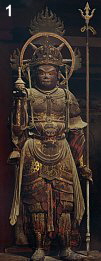 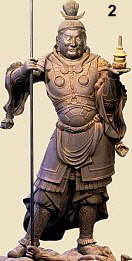 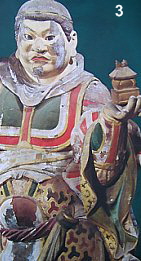  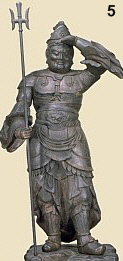
click any image to enlarge
|
- Bishamonten, 11th century (1078), Hōryūji Temple 法隆寺 (Nara), Wood with pigments, H = 123.2 cm. Bishamon uncharacteristically holds the stupa in his right hand. The statue is paired with an effigy of Kichijōten (his wife or kisaki 妃). Photo Comprehensive Dictionary of Japan's National Treasures. Kodansha 1985. ISBN 4-06-187822-0
- Bishamonten atop two demons, by Unkei 運慶. Wood. H = 147 cm, Dated +1186. Ganjōju-in Temple 願成就院 in Shizuoka. Found photo at this J-site. Also see Mori, Hisahi, Sculpture of the Kamakura Period, Published 1974.
- Bishamonten, By Unkei 運慶. Dated +1189. Painted Wood, H = 139.5 cm. Jōrakuji Temple 常楽寺, Kanagawa Pref. 神奈川. Gaudy colors added in later times. Photo Heibonsha Survey of Japanese Art, Vol. 11.
- Tobatsu Bishamonten. Heian Era. ICP. Camphor Wood (Kusu 樟), H 160 cm, Ichiboku Zukuri, Kanzeonji Temple 観世音寺, Dazaifu City, Fukuoka. Held aloft by Jiten, with two demon attendants. Photo from 仏師と訪ねる九州の仏像2.
- Bishamonten, Heian Era, Kurama Temple 鞍馬寺 (Kyoto), Nat'l Treasure, Wood, H = 176 cm. Bishamon using his left hand as a visor over his eyes. Kurama Dera 鞍馬寺, just north of Kyoto, is dedicated to Bishamon. Photo from Comprehensive Dictionary of Japan's National Treasures. Kodansha 1985. ISBN 4-06-187822-0.
|
|

 Writes the Metropolitan Museum of Art (New York) Writes the Metropolitan Museum of Art (New York)
"Bishamonten (or Tamonten) is usually identified by the miniature stupa -- both a symbol of the Buddhist Law and a special treasure granted him by the Buddha -- that he holds in his right hand. This small, youthful, but stern Bishamonten stands firmly on two scowling demons, Niranba and Biranba. His miniature stupa is supported on his left palm, while in his right hand he grasps a long lance. The shift of the stupa from the right to the left hand when Bishamonten is represented alone seems to have been introduced in Mikkyō mandalas at the beginning of the ninth century, thus establishing a new canon. The present statue was originally brightly colored, with floral and geometric patterns in paint and kirikane covering the layers of robes and armor. The small, shining eyes are inlaid. The sculpture is made of several pieces of wood, and its interior is hollowed out. Stylistically, the piece especially resembles a triad of sculptures made by TANKEI 湛慶 (+1173-1256) for the temple Sekkenji in Shikoku, and may therefore be attributed to an artist who closely followed Tankei's style or model in the first half of the thirteenth century."
PHOTO CAPTION. Bishamonten. Kamakura era (1185-1333), 1st half of 13th century, polychromed Japanese cypress, cut gold, inlaid crystal eyes. H 41.9 cm. Photo New York Metropolitan Museum of Art. |
|

|
Tobatsu Bishamonten 兜跋毘沙門天
Protects Capital Cities & Repulses Foreign Invaders
aka Tōhachi Bishamonten 刀八毘沙門天
aka Kōmyō Dai-ō 光明大王 (Great Radient King)
aka Jinja Taishō 深沙大将 (Great General of the Desert)
|
|

|
|
MANTRA
南無兜跋毘沙門天
Namu Tobatsu Bishamonten
"Hail Tobatsu Bishamonten"
Chanted to the deity to subjugate
demons and dispel enemies.
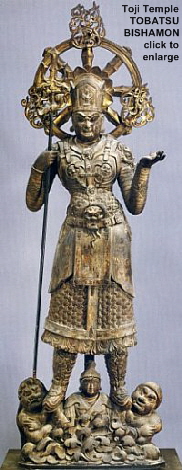
Oldest extant image of Tobatsu Bishamonten in Japan. Shown standing on the palms of earth goddess Jiten 地天. Flanked by two Jyaki 邪鬼 demons; to his right is Niranba; to his left Biranba. Heian Era (8th century). Wood. H = 189.4 cm. National Treasure. Tōji Temple 東寺 (aka Kyō-ō-gokokuji Temple 教王護国寺) in Kyoto. This statue was reporedly brought from Tang China and originally installed in the upper story of Rajōmon 羅城門, the main entrance to the capital Heiankyō 平安京 (Kyoto), in order to protect the capital city. This statue provided the model for subsequent Japanese images of him. Now housed at the Nara Nat'l Museum. For various views, see museum's web site. Photo: J-magazine 日本の仏像 #33. Text JAANUS.
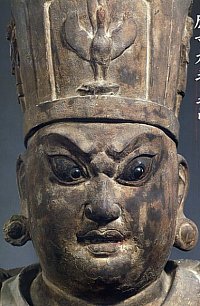
Closeup
|
|
Tobatsu Bishamon is one of many forms of Bishamon, one worshipped independently in Japan as well as China and Central Asia. Like Bishamon's other manifestations, Tobatsu is dressed in armor, looking ferocious, carrying a weapon, and a treasure pagoda. But his iconography thereafter differs most clearly from Bishamon/Tamon -- i.e., he wears a crown containing a bird emblem, is dressed in tight-fitting armor that falls down below his knees and squeezes in at his waist, and is commonly portrayed atop the upturned hands of earth goddess Jiten, who is flanked by two demons often identified as Niranba 尼藍婆 (Skt. = Nīla-vajra) and Biranba 毘藍婆 (Skt. = Vilambā).
Says JAANUS: "A manifestation of Bishamonten said to have appeared in the Central Asian kingdom of Tou-po or Tou-pa (Jp. = Tobatsu 兜跋) during the Tang dynasty. Although sometimes linked to Tu-fan 吐蕃 (ancient Tibet), the identity of this kingdom remains unknown. Tobatsu Bishamonten was invoked in particular for the protection of capital cities and the repulsion of foreign invaders, and depictions of him have been found among the murals of Tun-huang (Jp. = Tonkō 敦煌). The oldest image of him in Japan is a wooden statue preserved at Tōji Temple 東寺 in Kyoto (see photo at right), said to have been brought from Tang China and originally installed in the upper story of Rajōmon 羅城門, the main entrance to Heiankyō 平安京 (now Kyoto), in order to protect this former capital of Japan. This statue provided the model for subsequent Japanese images of him which are found most often in the Kyūshū 九州 and Tōhoku 東北 regions, where his cult appears to have flourished during the Heian period because of his alleged efficacy in repulsing foreign invaders to which these areas were particularly susceptible. Examples include those at Kanzeonji Temple 観世音寺 (see photos below) in Fukuoka prefecture, Eikōji Temple 永興寺 in Ōita prefecture, and Narushima Bishamondō 成島毘沙門堂 (see Fig. T1) in Iwate prefecture. <end JAANUS quote>
Editor's Note: Why is Bishamon standing in Jiten's upturned hands? Unknown, but Bishamon is the dispenser of earthly treasures, so it is perhaps befitting that Jiten (the earth deva) is appropriated for the task of upholding Bishamon.
JAANUS continues: Some of the sculptures of Tobatsu Bishamon in Japan are close copies of sculptures of the Tang dynasty (618-907) at Tōji Temple, said to have been imported into Japan in the early Heian period, reputedly by Kūkai (founder of Shingon Buddhism in Japan). Tobatsu Bishamon is said to have been accorded his role due to a story told in Sōkōsōden 宋高僧伝 [10th century work, circa 988]. In 742, when Tibet (Jp. = Toban 吐番) attacked Kizil (Jp. = Ansei 安西), the Chinese emperor ordered Amoghavajra (705–774; Jp. = Fukū 不空 or Fukū Kongō 不空金剛, one of the eight Shingon 真言 patriarchs) to pray to Bishamonten. Kōmyō Dai-ō 光明大王 (Great Radient King) then appeared in the upper story of the north gate of the castle and the enemies were defeated. Consequently, when a sculpture of Bishamon was made in China as a protector of a regal citadel, or capital city, it was this form (Kōmyō Dai-ō) that was made and called "Tobatsu" owing to its association with the country Tobatsu, another name for Tibet. However, this story has not been proven. <noteNOTE:
The Digital Dictionary of Buddhism, for example, gives another story: "In 765, Amoghavajra used his new rendition of the Scripture for Humane Kings (T 246) in an elaborate ritual to counter the advance of a 200,000-strong army of Tibetans and Uighurs which was poised to invade Chang'an. Its leader, Pugu Huaien, dropped dead in camp and his forces dispersed." > It does explain why the Tang-dynasty Bishamon of Tōji was, according to the temple chronicle TŌHŌKI 東宝記, originally placed in the Rajōmon 羅城門 of Kyoto. A dissimilar image, thought to have been modeled on a sculpture at Mt. Hiei 比叡, is the early Heian sculpture that is over four meters tall, located in the Narushima Bishamondō 成島毘沙門堂 (see Fig. T1 below) in Iwate prefecture. <end JAANUS quote>
Writes Japanese scholar Sasaki Kōzō: "The origin of the warrior-like Bishamonten was probably [derived] from the practice of worshipping images of human kings as military gods, which were later regarded as identical to those of Bishamonten. This explains why Tobatsu Bishamonten, unlike the same deity in ordinary form, is represented as a single independent object of worship." Sasaki also traces worship of Tobatsu Bishamonten back to not only Khotan, but to a statue of Kaniska in the Peshawar Museum, and to places like Balkh and Kapisa. <end quote> See Sasaki Kōzō, On a Problem of Tobatsu Bishamonten, Bijutsushi, Journal of the Japan Art History Society, Vol. 10, No. 2, November 1960.

|
|
|
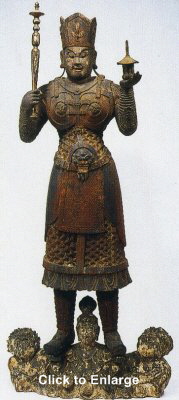
Tobatsu Bishamonten
Wood, H = 164 cm, 11th Century, ICP.
Heian-era copy of Tōji sculpture.
Stands on upturned palms of earth
goddess Jiten 地天. Flanked by two
Jyaki 邪鬼 demons. Among the oldest
extant images of Tobatsu Bishamon
in Japan. Photo Nara Nat'l Museum.
|
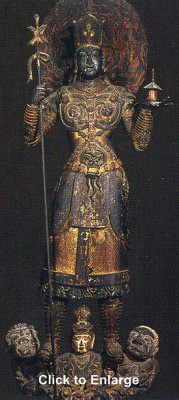
Tobatsu Bishamonten
Wood, H = 184.4 cm, ICP
Seiryōji Temple 清凉寺
Late Heian-era copy of the
Tōji sculpture (see image
above). Less dynamic and
fewer decorative details.
Photo 日本の仏像 #33, 2008.
|
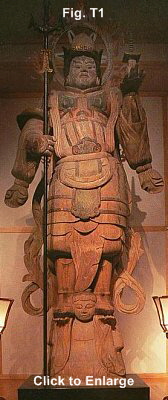
Tobatsu Bishamon at Narushima
Bishamondō 成島毘沙門堂,
Hanamaki City, Iwate Pref., ICP.
Heian Era, Wood, H = 3.59 meters.
Made from one piece of wood.
Wood = Keyaki 欅. Modeled
on a sculpture at Mt. Hiei 比叡
P = JR東日本の雑誌・トランヴェール
|
|
|

|
|
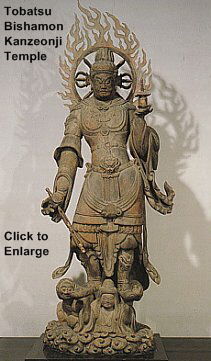
Tobatsu Bishamon, ICP, Heian Era
Wood (Kusu 樟), H 160 cm, Ichiboku Zukuri
Kanzeonji Temple 観世音寺
Dazaifu City 太宰府市, Fukuoka Pref.
Photo: Dazaifu Museum
|
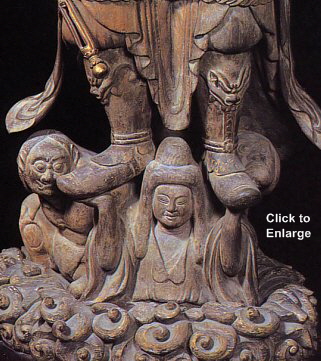
CLOSEUP
Tobatsu Bishamon, ICP, Heian Era
Wood (Kusu 樟), H 160 cm, Ichiboku Zukuri
Kanzeonji Temple 観世音寺
Photo: Dazaifu Museum
|
|
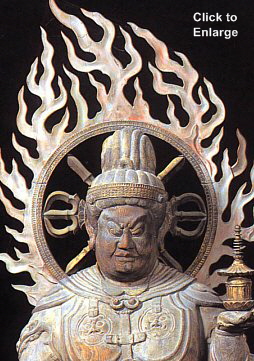
|
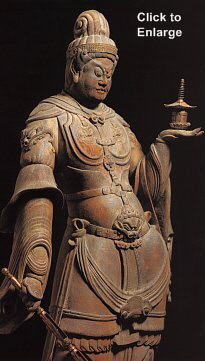 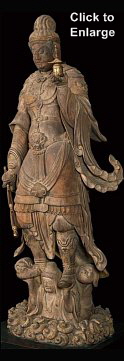
|
|
Above Photos = Various Views of Tobatsu Bishamon at Kanzeonji Temple (Daizifu City)
Photos from Dazaifu Bunkafureaikan Museum 大宰府市文化ふれあい館, Art and Archaeology,
and 仏師と訪ねる九州の仏像2, by Takai Sōgen 高井 王宗玄, ISBN978-4-87415 -815-9 C0071

|
|
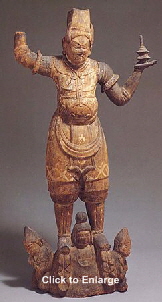
|
 Tobatsu Bishamonten, Late 10th to early 11th century Tobatsu Bishamonten, Late 10th to early 11th century
Polychromed Zelkova wood, H. 125.1 cm
Photo & Text: Metropolitan Museum of Art (New York)
Says the museum: "Bishamonten is considered the most powerful of the Guardian Kings, as his direction, the north, is associated with danger. Tobatsu Bishamonten is one of several manifestations of the deity. In this form he is worshipped alone, rather than with the other Guardian Kings. He stands supported by the earth goddess Jiten (Sanskrit: Prithivi) and two dwarf-demons, Niranba and Biranba. Befitting his protective function, he has an angry countenance and wears warrior's garb fashioned along the lines of Tang dynasty Chinese military uniforms. Five seated buddhas, now barely visible, are painted upon his tall crown. In his left hand he supports a stupa, his main identifying feature. His right hand may have held a vajra (a weapon symbolic of a thunderbolt) to ward off evil forces. With the exception of the arms, which are attached at the shoulders, the entire statue is carved of a single block of wood."
|
|

|
|
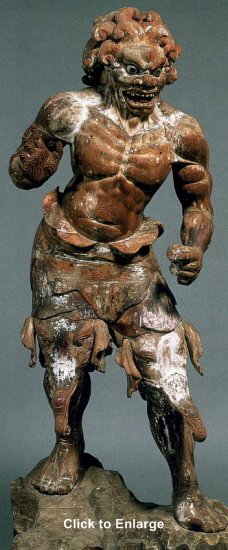
|
Jinja Taishō 深沙大将, Great General of the Desert.
1203 by Kaikei (d. 1226). Assembled woodblock construction,
H = 84.5 cm, Kongōin Temple 金剛院, Maizuru 舞鶴, Kyoto Pref.
Below text from John M. Rosenfield's book Portraits of Chogen:
The Transformation of Buddhist Art in Early Medieval Japan.
Published by Brill 2010. Photo scanned from book.
Says scholar Rosenfield (pp. 181-183): "This is a notably unfamiliar subject that emerged from Chinese folktales about the [Chinese] pilgrim Xuanzang 玄奘 (602–664), whose journey to India and return is one of the central episodes in the transmission of Buddhism in East Asia. Apocrypahl stories describe Xuanzang striding across the deserts west of Dunhuang, losing his water flask, and becoming desperately thirsty and discouraged. He dreamed of a giant figure with halberd who urged him to continue; soon he came to an oasis and was saved. In Chinese commentaries, the giant was an avatar of the Divine King Vaiśravaṇa (Jp. = Bishamon). A folk cult and its imagery thus developed in China and were transmitted to Japan in the 9th century. There the Desert General became well-enough recognized to be illustrated in the Esoteric Buddhist ritual handbook complied by the Japanese monk Kakuzen 覺禪 (active 12th century). The general also appears as Bishamon in a 14th-century Japanese handscroll illustrating Xuanzang's journey to India..........emerging from the [statue's] skirt are the heads of two flayed elephants. Adapted from an Indian custom of clothing gods in animal skins, the elephants imply that the deity is endowed with power superior to that of the animal." <end quote>
Says the Digital Dictionary of Buddhism: "Guardian god for all who face difficulties in the desert and for practitioners of the Lotus Sūtra. It is said that when Xuánzàng 玄奘 (602–664) journeyed to India he had a vision of this god in the desert. This was the model for Sha Wujing, one of Xuánzàng's disciples in the Ming novel Xīyóujì 西遊記 (Journey to the West). Regarded as a transformation of Vaiśravaṇa. Also referred to as 央掘摩羅 (Chn. = Yāngjuémóluó, Jp. = Ōkutsumara) or as Guanyin (Jp. = Kannon) in ritual commentaries 儀軌 (Chn. = Yíguǐ, Jp. = Giki)." <end quote>
|
|
|

|
|
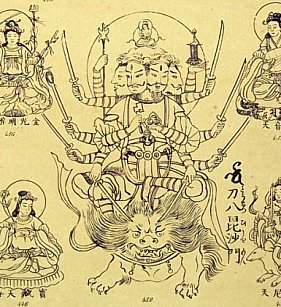
Tobatsu Bishamonten 刀八毘沙門天.
12 arms, four heads, and mounted on a lion.
From Philipp Franz von Siebold in his Nippon Archiv zur
Beschreibung von Japan. Leiden (1831 CE). Siebold got
the image from Butsuzō-zu-i. View book by Siebold
Photo Page | Index Page | Top Page
|
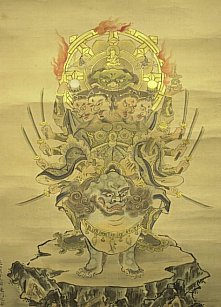
Tobatsu Bishamonten 刀八毘沙門天.
12 arms, four heads, and mounted on a lion.
Hanging scroll, circa 1832, attributed to artist
Hanabusa Ikkei 英一珪 (1749-1844).
At the British Museum.
Photo from Prints of Japan.
|
|

|
|
|
Chinese Artwork of Bishamon & Tobatsu Bishamon
|
|
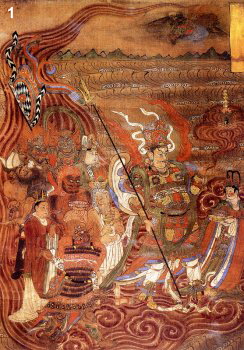
Vaiśravaṇa & Attendants
moving across the waters
Tang Dynasty, 9th century
|
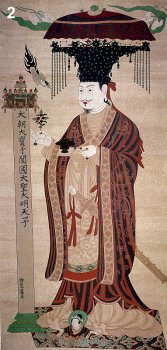
King of Khotan (9th century).
Descendent of Vaiśravaṇa,
shown atop hands of earth deva
|
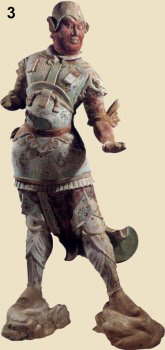
Vaiśravaṇa,
King of the North.
8th century, painted clay
|
- Vaiśravaṇa moving across the waters, Tang Dynasty, 9th century, ink and colors on silk, H = 37.6 cm, W = 26.6 cm, Britsh Museum Stein Painting 45. In this picture, Vaiśravaṇa is crossing the sea accompanied by warriors possessing divine power. Vaiśravaṇa holds a golden halberd in his right hand and a stupa in his left palm. Before him a heavenly attendant carries a tray with golden flower design; an elderly savant stands on the side. At the top of the painting there is a warrior who shoots down a feathered flying thunder monster. Discovered in the Library Cave, Dunhuang.
- Donor Portrait of the King of Khotan, Cave 98, Mogao Grottoes, Five Dynasties, 907-979 AD, H = 302 cm, W = 145 cm. This is a replica of a mural painting found in cave 98. Says the Dunhuang catalog: "This is a portrait of Li Shengtian, King of Khotan. Under his feet is a female deity half emerging from the earth and supporting his two feet. Legend has it that the king of Khotan is the descendant of the deva-king of the north (i.e., Vaisravana), born from the forehead of the deva-king. All the kings of Khotan worshipped the deva-king of the north." <end quote> More precisely, the 7th century Mahāmāyūrī Sūtra 孔雀明王經 (translated by Hsüan Tsang 玄奘 (Jp. = Genjō, 600–664) says Vaisravana is the protector of the people of Tokhara, the region around the Oxus river basin. Writes scholar Chaudhuri, pages 23: "The account of Khotan [in this sutra] says the king (at that time) claimed to be a descendent of Vaisravana. One of his childless ancestors had prayed to Vaisravana for a son, and Vaisravana subsequently produced a child from his head for the childless king."
- Vaisravana, Cave 194, Mogao Grottoes, High Tang Dynasty, 705-780 AD, H = 132 cm. This is a modern replica of a painted clay sculpture found in cave 194.
PHOTO SOURCE: Above three images and text from: DUNHUANG: A Centennial Commemoration of the Discovery of the Cave Library. ISBN 7-5054-0716-3/J-0396. First published in 2000 by Morning Glory Publishers, Beijing, China
|
|

|
COMPARING ICONOGRAPHY OF BISHAMON / TAMON IN JAPAN
|
|
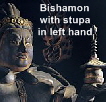 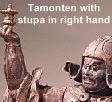  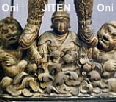 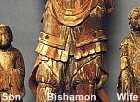
- Dressed in armor (yoroi 鎧) & looking ferocious (funnusō 忿怒相). All manifestations of the deity.
- Standing on a rock. The rock symbolizes Mt. Sumeru (Jp. = Shumisen 須弥山), the giant mountain at the center of the Buddhist universe, the mythical home of the Historical Buddha. Mt. Shumisen is surrounded by four continents, with Bishamon/Tamon guarding the northern continent, as well as the northern slope of Mt. Shumisen. The rock can be used for any form of the deity.
- Standing atop (trampling) one or two Jyaki 邪鬼 (demons). The demons are typically considered to be Yasha 夜叉 and/or Rasetsu 羅刹 (evil earth spirits & demons who eventually converted to Buddhism). This iconographical type is prevalent for statues of both Bishamonten and Tamonten.
- Standing atop the upturned palms of earth goddess Jiten 地天 while flanked by two subjugated demons known as Niranba 尼藍婆 (Skt. = Nīla-vajra, Blue Thuderbolt, female) and Biranba 毘藍婆 (Skt. = Vilambā, male). Biranba is one of ten Dharma-protecting Rasetsu (Skt. = rākṣasīs) mentioned in the Lotus Sutra. This is the most prevalent iconographical type for Tobatsu Bishamonten. Although Tamonten is sometimes depicted in the same fashion (as at Tōji Temple in Kyoto), this iconography is generally reserved for Tobatsu Bishamon.
- Holding a stupa (hōtō 宝塔 or 寶塔). Bishamon commonly holds it in his left hand, while Tamonten typically holds it in his right. But there are exceptions. At Hōryūji Temple 法隆寺 (Nara), Bishamon is shown with pagoda in right hand, while at Jōruriji Temple 浄瑠璃寺 (Kyoto), Tamonten is holding the stupa in his left hand. Elsewhere, Bishamon is depicted without a stupa at Kyoto's Kurama Dera Temple 鞍馬寺, and instead shown using his left hand as a visor (as if keeping watch for enemies). These latter depictions are relatively rare.
- Flanked by his wife Kichijōten 吉祥天 and his son Zennishi Dōji 善膩師童子. Some Japanese claim the youth is instead Zenzai Dōshi 善財童子 (Skt. = Sudhana-śreṣṭhi-dārak). Other sources say Kichijōten and Zennishi Dōji are merely attendants, not wife and son. This iconography related specifically to Bishamonten.
- Holding a weapon. Nearly always shown holding a weapon, which can vary, but in many cases it is a trident (sansageki 三叉戟), baton (hōbō 宝棒), halberd (hōko 鋒), or lance (shura 輸羅). Depending on his manifestation, either the right or left hand will hold the weapon.
- Circular Halo. All manifestations of the deity are often shown with a wheel (circular) halo with flames and/or eight spokes. The circular halo symbolizes divinity, and is found on numerous Buddhist deities. The wheel (or eight-spoked circle) represents the Wheel of Law (Rinpō 輪宝), which refers to the teaching / preaching of the law among the masses (i.e., turning the wheel of the law). The flame symbolizes purification and the burning away of attachment (desire).
|
|

|
BISHAMONTEN AS ONE OF TWELVE DEVA
Member of the Happōten 八方天, Jitten 十天, and Jūniten 十二天
|
|

|
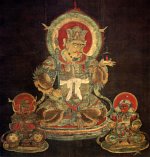
Bishamon sitting, flanked by two attendants. Very rare depiction, as Bishamon is traditionally shown standing. Heian Era
(1127). Painted scroll. H = 144.2 cm, W = 126.6 cm. From a set of 12 scrolls of all 12 Deva. National Treasures. Tōji Temple 東寺
(aka Kyō-ō-gokokuji Temple
教王護国寺) in Kyoto.
|
|
 The 12 Deva Guardians (Jūniten 十二天) are a group of protective deities of Hindu origin. They guard the 12 directions in Esoteric Buddhism (Mikkyō 密教). Bishamonten (Vaiśravana) is the lord of the north, and commonly depicted holding a stupa in one hand and a rod in the other. The 12 originated from the Hindu guardians of the four cardinal and four intermediary directions, known as the Eight Directional Deva (Jp. = Happōten 八方天). In later years, the gods of heaven and earth were added to create a grouping called the Ten Deities (Jp. = Jitten 十天), and still later the gods of the sun and moon were added to create the Jūniten (Group of 12 Deva). These twelve generally supplant the Shitennō (Four Heavenly Kings) in esoteric traditions in Japan, although they serve the same role as the Shitennō in protecting Buddhism and crushing evil. As a group, the 12 appear frequently from the mid-Heian (794-1185) onward in mandala paintings (e.g. Taizōkai Mandala, Anchin Mandala, Jūniten Mandala, Ninnōgyō Mandala), as sets of scroll paintings, as processional masks, or as pairs on six-paneled folding screens called Jūniten Byōbu 十二天屏風. Their images were hung during the Latter Seven-Day Rite (Goshichinichi no Mishiho 後七日御修法), an annual ceremony of esoteric prayers performed in the first month of each year at the Shingon-in of the Imperial Palace for the regeneration of the emperor, state, and realm. See our 12 Deva Page for more. The 12 Deva Guardians (Jūniten 十二天) are a group of protective deities of Hindu origin. They guard the 12 directions in Esoteric Buddhism (Mikkyō 密教). Bishamonten (Vaiśravana) is the lord of the north, and commonly depicted holding a stupa in one hand and a rod in the other. The 12 originated from the Hindu guardians of the four cardinal and four intermediary directions, known as the Eight Directional Deva (Jp. = Happōten 八方天). In later years, the gods of heaven and earth were added to create a grouping called the Ten Deities (Jp. = Jitten 十天), and still later the gods of the sun and moon were added to create the Jūniten (Group of 12 Deva). These twelve generally supplant the Shitennō (Four Heavenly Kings) in esoteric traditions in Japan, although they serve the same role as the Shitennō in protecting Buddhism and crushing evil. As a group, the 12 appear frequently from the mid-Heian (794-1185) onward in mandala paintings (e.g. Taizōkai Mandala, Anchin Mandala, Jūniten Mandala, Ninnōgyō Mandala), as sets of scroll paintings, as processional masks, or as pairs on six-paneled folding screens called Jūniten Byōbu 十二天屏風. Their images were hung during the Latter Seven-Day Rite (Goshichinichi no Mishiho 後七日御修法), an annual ceremony of esoteric prayers performed in the first month of each year at the Shingon-in of the Imperial Palace for the regeneration of the emperor, state, and realm. See our 12 Deva Page for more. |
|
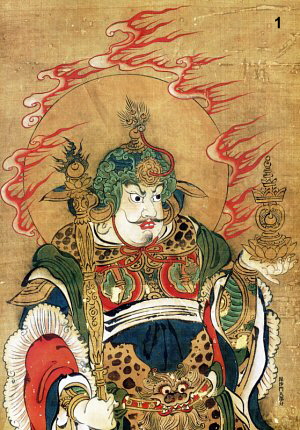 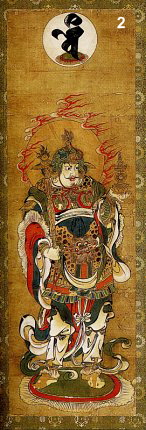 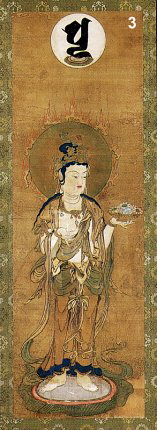
|
- Closeup of Bishamon, from a set of six-panelled folding screens known as Jūniten Byōbu 十二天屏風. Painted by Takuma Shōga 宅間勝賀 and dated to 1191, these are the oldest extant Japanese examples of such screens. They are preserved at Tōji Temple 東寺 in Kyoto. Each panel is 130 cm in height and 42.1 cm in width.
- Full view of the Bishamon panel.
- Image of the earth deva Jiten 地天 (Skt. Prthivi); represents "Down." In statuary, Bishamon is often shown standing atop the upturned palms of this earth goddess.
Above images scanned from Tōji Temple Catalog entitled 東寺国宝展 (National Treasures of Tōji), published in 1995 to commemorate the temple's 1,200 year anniversary. Published by Asahi Shimbun.
|
|

|
BISHAMONTEN AND KANNON
Protector of Devotees of the Lotus Sutra
One of 28 Guardians of Senju Kannon, One of 33 Forms of Kannon
|
|

|
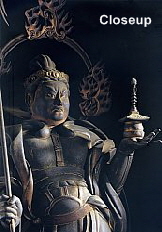 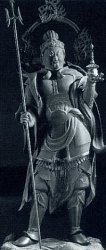
|
Bishamonten as one of 28 Deities protecting Senju Kannon (1000-Armed Kannon). National Treasure, Kamakura Period, 13th Century, Wood, H = 161 cm. Yosegi Zukuri 寄木造 (Joined-Block Technique, Assembled-Wood Method). Located at Sanjūsangendō 三十三間堂 (aka Myō-hō-in, Renge Ō-in 妙法院蓮華王院) in Kyoto. Photo scanned from temple's catalog.
Bishamonten is listed as one of the 33 forms of Avalokitêśvara (Jp. = Kannon, Goddess of Mercy) in the Lotus Sūtra's Fumon Bon 普門品 (Chapter of the Universal Gate).
|
|
|
|
 Bishamon is one of the Nijūhachi Bushū 二十八部衆, translated as 28 Legions (or 28 Attendant Deities) Serving the 1,000 Armed Kannon. This group of 28 appears in the Tang era (7th to 9th centuries) in Chinese translations of texts devoted to Kannon (e.g. 千手観音造次第法儀軌). In Japan, the list of the 28 varies among temples and sects. Life-size statues of all 28 (dated to the mid-13th century) are housed at Sanjūsangendō 三十三間堂 in Kyoto, where they guard the principal statue of Senju Kannon (11-feet tall). See 28 Legions Page for details. Bishamon is also one of the Sanjūsanshin 三十三身, translated as 33 Forms of Kannon. The 25th chapter of the Lotus Sutra (Hoke-kyō 法華経) -- first translated into Chinese by Kumārajīva 鳩摩羅什 (350 - 410) -- lists thirty-three forms that Kannon assumes when aiding sentient beings, including that of Bishamon, a monk, nun, official, general, king, child, naga (dragon), garuda, and a yakṣa. However, in Japanese statuary and artwork, the 33 forms do not always conform to the 33 forms listed in the Lotus Sutra, yet Japan's traditions remain faithful to the notion that Kannon appears in myriad forms to save people. The names of the 33 also vary depending on temple or sect. In Japan, there are numerous 33-site pilgrimage circuits sacred to Kannon. Many of the temples along these circuits feature statues of Bishamonten. See our Sanjūsanshin page for a full listing of the 33 Forms of Kannon. Additionally, Bishamonten is the central object of worship at Kurama Dera 鞍馬寺, a temple just north of Kyoto that acts to protect Kyoto's northern areas. The temple's founding legends all equate Bishamon with Kannon. See Kurama Dera below for details. Elsewhere, Kōfukuji Temple 興福寺 (Nara) discovered various 13th-century devotional drawings of Bishamon placed inside a standing statue of an 11-Headed Kannon (also at Kōfukuji). See Drawings #4 & #5 below. Bishamon is one of the Nijūhachi Bushū 二十八部衆, translated as 28 Legions (or 28 Attendant Deities) Serving the 1,000 Armed Kannon. This group of 28 appears in the Tang era (7th to 9th centuries) in Chinese translations of texts devoted to Kannon (e.g. 千手観音造次第法儀軌). In Japan, the list of the 28 varies among temples and sects. Life-size statues of all 28 (dated to the mid-13th century) are housed at Sanjūsangendō 三十三間堂 in Kyoto, where they guard the principal statue of Senju Kannon (11-feet tall). See 28 Legions Page for details. Bishamon is also one of the Sanjūsanshin 三十三身, translated as 33 Forms of Kannon. The 25th chapter of the Lotus Sutra (Hoke-kyō 法華経) -- first translated into Chinese by Kumārajīva 鳩摩羅什 (350 - 410) -- lists thirty-three forms that Kannon assumes when aiding sentient beings, including that of Bishamon, a monk, nun, official, general, king, child, naga (dragon), garuda, and a yakṣa. However, in Japanese statuary and artwork, the 33 forms do not always conform to the 33 forms listed in the Lotus Sutra, yet Japan's traditions remain faithful to the notion that Kannon appears in myriad forms to save people. The names of the 33 also vary depending on temple or sect. In Japan, there are numerous 33-site pilgrimage circuits sacred to Kannon. Many of the temples along these circuits feature statues of Bishamonten. See our Sanjūsanshin page for a full listing of the 33 Forms of Kannon. Additionally, Bishamonten is the central object of worship at Kurama Dera 鞍馬寺, a temple just north of Kyoto that acts to protect Kyoto's northern areas. The temple's founding legends all equate Bishamon with Kannon. See Kurama Dera below for details. Elsewhere, Kōfukuji Temple 興福寺 (Nara) discovered various 13th-century devotional drawings of Bishamon placed inside a standing statue of an 11-Headed Kannon (also at Kōfukuji). See Drawings #4 & #5 below. |
|

|
EXPELLER OF ILLNESS AND DEMONS OF PLAGUE
|
|

 The Shigisan Engi Emaki 信貴山縁起絵巻 (Illustrated Handscroll of the Legends of Mt. Shigi), was painted in the 12th century as a tribute to Bishamon's miraculous power to ward off illness and expel the demons of plague. It includes the story of how Bishamon cured Emperor Daigo 醍醐天皇 (885-930) by dispatching Kumāra 倶摩羅 (Bishamon's youthful dōji 童子 attendant) to help the sick emperor. The Shigisan Engi Emaki 信貴山縁起絵巻 (Illustrated Handscroll of the Legends of Mt. Shigi), was painted in the 12th century as a tribute to Bishamon's miraculous power to ward off illness and expel the demons of plague. It includes the story of how Bishamon cured Emperor Daigo 醍醐天皇 (885-930) by dispatching Kumāra 倶摩羅 (Bishamon's youthful dōji 童子 attendant) to help the sick emperor.
Bishamon appears in other painted scrolls of the same period. Says the Tokyo National Museum (about adjacent image): "Here, Bishamonten is portrayed as a benevolent deity who protects devotees of the Lotus Sutra. Examples of Bishamon holding a bow, as he is painted here, are found in Chinese works of the Tang (618-907) and Song (960-1279) dynasties. This scroll, called the Extermination of Evil (Hekija-e) or Exorcists Scroll, is conjectured to have been made during the time of Emperor Goshirakawa (1127-92, r. 1155-58) in the latter part of the Heian period (794-1185) and kept in the treasure house of Rengeo-in Temple (Sanjusangendo). All the deities shown here [in the five scolls] are considered, in China, to be benevolent deities who expel the demons of plague. This set was originally mounted as a handscroll that was known as the 'second edition of the Masuda family Hell Scroll.' After the war, the hand scroll was cut into five sections and the paintings mounted as hanging scrolls. The acts of each of the gods in exterminating evil are briefly explained in the texts accompanying the illustrations. <end text from Tokyo National Museum> |
|

|
BISHAMONTEN DRAWINGS FROM MEDIEVAL PERIOD
|
|
 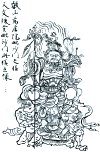 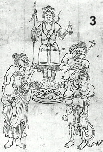   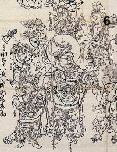
|
- Bishamonten and 30 Attendants. The iconography of the system suggests the influence of Mt. Hiei's Tendai sect. Image from the Besson Zakki 別尊雑記 (Miscellaneous Notes on Individual Deities), compiled in the late 12th to early 13th centuries, which provides illustrations of many Buddhist deities and their attributes.
- Bishamonten atop Jiten, flanked by two demons. Another drawing from the Besson Zakki.
- Tobatsu Bishamonten and Four Attendants (unidentified). Ink on Paper, 12th-13th Century, H 51.3 cm, W 28.4 cm, Museum of Fine Arts, Boston
- Polychrome drawing of Bishamon with numerous stamped images of Bishamon, sumi print on paper, H 56.4 cm, W = 32.3, Kamakura Era (1223), Treasure of Kōfukuji Temple 興福寺 in Nara. This drawing, along with others, were discovered inside a standing statue of an 11-Headed Kannon (also at Kōfukuji). Photo from 興福寺国宝展・鎌倉復興期のみほとけ (National Treasures of Kōfukuji from the Temple Revival of the Kamakura Period), published 18 Sept. 2004, Asahi Shimbun.
- Closeup of Fig. 4 above.
- Bishamonten in the Ninnōgyō Gohō Shozon-zu 仁王経五万諸尊図. Northern Section 北方, H = 150.6 cm, W = 96 cm, 14th-15th Century, Tōji Temple (Kyoto)
also see 10th-century drawing of Tobatsu Bishamon at Tokyo University's site.
|
|

|
BISHAMONTEN WITH WIFE AND CHILD
Kichijōten 吉祥天 and Zennishi Dōji 善日童子
|
|
Kichijōten 吉祥天 (aka Kisshōten 吉祥天) is the goddess of beauty and fortune. She is the wife of Vishnu in Hindu myths, but in Buddhist texts and iconographies she appears as the wife of Bishamonten (e.g., Sange Shidai 山下次第, a Japanese text of the ?? century, says she is the wife of Bishamonten, but the 8th-century text Dainichi-Kyō-Sho 大日經疏 (T 1796) says she is a subordinant of Bishamon). She was worshipped widely in the Nara and Heian periods. By the late 17th century she was worshipped as one of Japan's Seven Lucky Gods, but today she is largely forgotten (she is no longer a member of the seven), and her cult has been largely supplanted by goddess Benzaiten. Elsewhere, the Taimitsu 台密 branch of the Tendai school worships a deity called Sōshin Bishamonten 雙身毘沙門天, which combines an effigy of Bishamon with one of Kichijōten, placing them back to back. See Syncretic Associations below (Fig. 6) for details.
|
|
 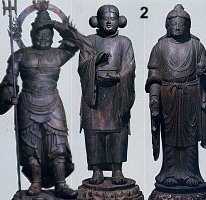 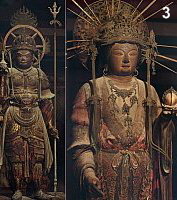 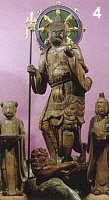
|
- Bishamonten Sanzonzō 毘沙門天三尊像 (Bishamonten Triad). Bishamonten flanked by his wife Kichijōten 吉祥天 and his son Zennishi Dōji 善膩師童子. Wood, 13th Century, H = 168 cm, ICP, Sekkeiji Temple 雪蹊寺, Kōchi City 高知市, Kōchi Pref. Carved by TANKEI 湛慶 (+1173-1256), Unkei's eldest son and main apprentice. TANKEI was an acclaimed sculptor of the dominant Keiha school during the Kamakura period. During repairs in the Taishō era 大正時代 (1912-1926), an inscription was found inside the statue, naming its maker as TANKEI . Photo: 日本の仏像 #33.
Made from Cypress (Hinoki ヒノキ), Yosegi-zukuri Technique 寄木造. Also see Kochi City J-site about this triad.
- Bishamonten 毘沙門天三尊像, his his son Zennishi Dōji 善膩師童子, and his wife Kichijōten. Wood. 11th-12th Century. Bishamon H = 176 cm, Zennishi Dōji H = 95 cm, and Kichijōten H = 100 cm. Kurama Temple 鞍馬寺 (Kyoto), National Treasures.
- Bishamonten and Kichijōten, 11th century (1078), Hōryūji Temple 法隆寺 (Nara), Wood with pigments, Bishamonten H = 123.2 cm, Kichijōten H = 116.7 cm. Bishamon uncharacteristically holds the stupa in his right hand. Photo from Comprehensive Dictionary of Japan's National Treasures. Kodansha 1985. ISBN 4-06-187822-0. Nat'l Treasures.
- Bishamon standing atop demon, attended by wife (Kichijōten 吉祥天) and attendant (Zenzai Dōshi 善財童子). Late Heian Period, H = 111.5 cm, Wood, Keyaki ケヤキ, Ichiboku Zukuri 一木造 (all three). ICP of Miyagi Prefecture. Kichijōten and Zenzai Dōshi, and stupa made in later centuries. The demon was made in recent years, and has lost all trace of its former appearance. The central image was reportedly venerated by farmers asking for agricultural blessings. Attributed to Saichō 最澄 (767 - 822), founder of Japan's Tendai school, but this is highly unlikely. Treasure of Kōfukuji Temple 興福寺 in Kurihara City 栗原市 (Miyagi). Photo from Miyagi Prefecture web site.
|
|
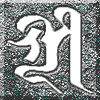
Sanskrite Seed シリー
KICHIJŌTEN 吉祥天
Pronounced SHIRII in Japan
|

Sanskrite Seed ベイ
BISHAMONTEN 毘沙門天
Pronounced VAI or BEI in Japan
|

Sanskrit Seed キャ
ZENNISHI DŌJI 善日童子
Pronounced KYA in Japan
|
|
Sanskrit Images Used With Permission from This J-Site
|
|
|
|

|
KURAMA DERA, BISHAMON & KANNON
|
|

|
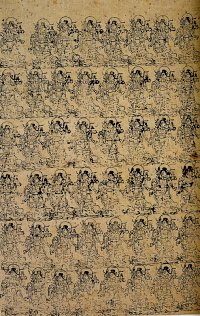
|
|
Stamped Bishamon, Sumi print on paper, H 40.0 cm, W 26.5 cm, Kamakura Era, dated around 1220-1228, Treasure of Kōfukuji Temple 興福寺 in Nara. This drawing, along with others, were discovered inside a standing statue of an 11-Headed Kannon (also at Kōfukuji). Photo from 興福寺国宝展・鎌倉復興期のみほとけ (National Treasures of Kōfukuji from the Temple Revival of the Kamakura Period), published 18 Sept. 2004, Asahi Shimbun.
|
|
 Kurama Dera 鞍馬寺 is located just north of Kyoto. It was built in the late 8th century to protect the northern areas of Kyoto, and most befittingly, it is dedicated to Bishamonten, the guardian of the north. Even today it is one of the most important temple's dedicated to Bishamon, and it houses important statues of Bishamon, his wife Kichijōten, and their son Zennishi Dōji (see above). The area around the temple and Mt. Kurama is also the legendary abode of the white-haired Sōjōbō 僧正坊, King of Tengu. The bird-like Tengu are skilled warriors and mischief makers, especially prone to playing tricks on arrogant and vainglorious Buddhist priests. They possess supernatural powers and are venerated as patrons of the martial arts. According to a well-known Japanese legend, the hero of medieval Japan -- Minamoto Yoshitsune 源義経 (1159-1189) -- was trained here in sword fighting by King Sōjōbō himself. Yoshitsune is one of Japan's most beloved warriors from this period, one who helped his brother Minamoto Yoritomo 源頼朝 (1147-1199; the first shogun), defeat the Taira Clan to establish the Kamakura Shogunate, only to turn against his brother in an unsuccessful venture with the cloistered Emperor Go-Shirakawa 後白河天皇 (1127-1192). Yoshitsune was eventually betrayed and forced to commit suicide. In related matters, the early 11th-century text Mutsu Waki 陸奥話記 says Yoritomo is an incarnation of the god of the north, i.e. Bishamon. Kurama Dera 鞍馬寺 is located just north of Kyoto. It was built in the late 8th century to protect the northern areas of Kyoto, and most befittingly, it is dedicated to Bishamonten, the guardian of the north. Even today it is one of the most important temple's dedicated to Bishamon, and it houses important statues of Bishamon, his wife Kichijōten, and their son Zennishi Dōji (see above). The area around the temple and Mt. Kurama is also the legendary abode of the white-haired Sōjōbō 僧正坊, King of Tengu. The bird-like Tengu are skilled warriors and mischief makers, especially prone to playing tricks on arrogant and vainglorious Buddhist priests. They possess supernatural powers and are venerated as patrons of the martial arts. According to a well-known Japanese legend, the hero of medieval Japan -- Minamoto Yoshitsune 源義経 (1159-1189) -- was trained here in sword fighting by King Sōjōbō himself. Yoshitsune is one of Japan's most beloved warriors from this period, one who helped his brother Minamoto Yoritomo 源頼朝 (1147-1199; the first shogun), defeat the Taira Clan to establish the Kamakura Shogunate, only to turn against his brother in an unsuccessful venture with the cloistered Emperor Go-Shirakawa 後白河天皇 (1127-1192). Yoshitsune was eventually betrayed and forced to commit suicide. In related matters, the early 11th-century text Mutsu Waki 陸奥話記 says Yoritomo is an incarnation of the god of the north, i.e. Bishamon.
Kurama Dera is also a major sanctuary for Kannon Bosatsu. Indeed, in the temple's foundation stories, we discover that Bishamonten is a manifestation of Kannon. There are at least three versions of the story, each slightly different:
- Fusō Ryakuki 扶桑略記, a text dated to 1150 AD, tells the story of Fujiwara no Isendo 藤原伊勢人 (759-827), who wants to build a temple dedicated to Kannon. The deity appears to him in a dream and shows him the place. Upon awakening, he mounts a horse and rides northward until he finds the spot, where he discovers an idol of Bishamon. He returns home, not knowing what to do. A youth appears to him in a dream and says Kannon and Bishamon are the same deity. So Fujiwara builds a sanctuary at that location for Bishamon.
- Kuramafutadera Engi 鞍馬蓋寺縁起, written around 1340, says monk Gantei (Kantei) 鑑禎, in the year 770, dreamt that a white horse with jewel-studded saddle guided him to this holy site. When he awoke, he mounted a horse, which led him to this sacred spot, where he found an idol of Bishamon, and thereafter he built a small thatched sanctuary for it. Later, in 796, Fujiwara no Isendo, still hoping to build a temple dedicated to Kannon, dreamt as well of a white horse with jewel-studded saddle that guided him to the same location. When he visited the site, he found an idol of Bishamon. Not knowing what to do, he returned home, but that evening, in a dream, he is told that Kannon and Bishamon are the same deity. He thereafter built a hall for the Bishamon idol and also installed an idol of Kannon therein.
- Wakan Sansai Zue 和漢三才図会, circa 1712, says Fujiwara no Isendo dreamt of a suitable place to construct a temple for Kannon. So he saddled his white horse and instructed a servant boy to ride it, telling him to let the horse go wherever it pleased. The animal eventually led the boy to the sacred spot, where it suddenly stopped. When informed of the situation, Fujiwara visited the location and found an idol of Bishamon. He thereafter built a temple for the deity, but remained unhappy because his real intention had been to build a hall dedicated to Kannon. He then had another dream, telling him that Bishamon and Kannon were the same deity with different names. He then built another hall and installed a Kannon image therein.
- SPECULATIVE. One of Kannon's many esoteric forms is Batō Kannon 馬頭観音 (lit. = Horse-Headed Kannon). Artwork of the deity is distinguished by the white horse's head worn atop its crown. The horse is one of the symbols of dominion of the "Ideal King" (Kyōryōrinjin 教令輪身 or Kyōryōjō-ō 教令聖王), known as Chakravartin in Sanskrit. Perhaps Bishamon is linked to Kannon via this channel (i.e., white horse, or white horse's head) as well.
Kurama Dera literally means "Horse Saddle Temple," a befitting moniker as both Gantei and Fujiwara were both guided there on saddle-back.
|
|
KURAMA DERA'S BISHAMON STATUE
|
|
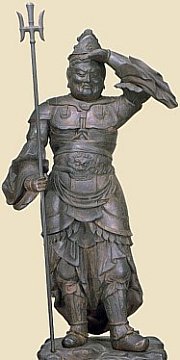
Bishamonten, Wood, H = 176 cm
Kurama Temple 鞍馬寺, Kyoto
Heian Era, Nat'l Treasure
|
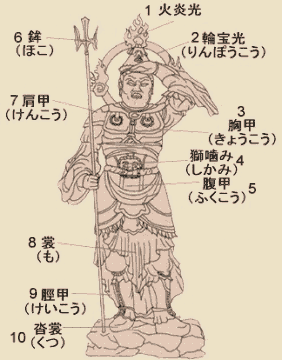
Bishamon chart
courtesy of Kokufuku J-Site
see chart below for terms and definitions
|
|
1. Kaenkō 火炎光
|
flame nimbus; flame design in wheel halo
|
|
2. Rinpōkō 輪宝光
|
also spelled 輪寶光; wheel-shaped halo
|
|
3. Kyōkō 胸甲
|
breastplate, armor
|
|
4. Shikama 獅噛み
|
lion head emblem; image of the shishi 獅子
|
|
5. Fukukō or Fukkō 腹甲
|
plastron, protective armor
|
|
6. Hō or Hōko 鋒
|
halberd (or weapon like a trident, spear, lance)
|
|
7. Kenkō 肩甲
|
shoulder armor
|
|
8. Mo 裳
|
robe, skirt
|
|
9. Keikō 脛甲
|
leg (shin) armor
|
|
10. Kutsu 沓裳
|
protective footwear
|
|

|
SYNCRETIC FORMS, SYNCRETIC ASSOCIATIONS
|
|
Bishamonten comes in various sycretic forms, including
- Sanmen Daikokuten 三面大黒天. Three-Headed Daikokuten, Benzaiten & Bishamonten.
- Tenkawa Benzaiten (Uga Benzaiten), with Bishamon and Daikoku as attendants.
- Shōgun Jizō 勝軍地蔵 (Victorious Jizō, Army-Conquering Jizō) and Shōteki Bishamon 勝敵毘沙門 (Enemy-Conquering Bishamon). Both appear in the artwork of Mt. Atago.
- Sōshin Bishamonten 雙身毘沙門天 or 双身毘沙門天, a dual-body form incompassing Bishamon-ten and Kichijō-ten (his wife) standing back to back.
|
|
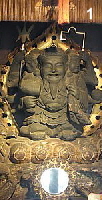 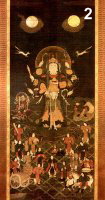 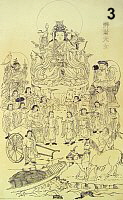   
click any image to enlarge
|
- Sanmen Daikokuten 三面大黒天 (Three-Headed Daikokuten). Wood, Late 17th Century, Eishinji Temple 英信寺, Tokyo. A special three-headed form of Daikokuten 大黑天, appearing around the latter half of the 14th century in the Tendai school and gaining great popularity in the Edo period. The center face is Daikokuten, the left Bishamonten, and the right Benzaiten 弁才天). All three were introduced independently to Japan in the 6th-8th centuries and originally served as state-protecting warrior deities. In this particular three-headed form (there are others), he is a war deity who conquers evil, but in the centuries that followed his introduction, he became a benevolent deity who awards followers with wealth and good fortune. The three heads are also said to protect the Three Buddhist Treasures (the Buddha, the law, and the community of followers). Today each of these three Hindu-derived deities is worshipped in his/her own right, and all three are popular members of Japan's 7 Lucky Gods. View Daikokuten page for details. Photos courtesy this J-site.
- Uga Benzaiten Mandala (Tenkawa Benzaiten) 天川弁才天曼荼羅. The snake-headed Benzaiten (Uga Benzaiten) surrounded by the black-colored Daikokuten holding his magic mallet and bag, by Bishamonten holding his pagoda of treasure, and by Benzaiten's 15 disciples. Above the 8-armed central deity are two astral bodies floating on clouds (probably the sun and moon), and two flying white foxes. These foxes probably represent Inari, the kami of rice and wealth, and Dakini, the Hindu-Buddhist goddess of wealth. Both are associated with white foxes. Ugajin (human-headed snake) and a shrine gate appear atop Benzaiten's head. Photo from this J-site. Dated to the 16th or 17th century (guesstimate). These are complex waters, which will be discussed in detail sometime in the near future on our Benzaiten page.
- Uga Benzaiten, Her 15 Disciples, along with Bishamonten and Daikokuten. As appearing in Philipp Franz von Siebold. Nippon Archiv zur Beschreibung von Japan. Leiden (1831 CE). Siebold got this image from the Butsuzō-zu-i 仏像図彙, "Collected Illustrations of Buddhist Images." Published 1690 (Genroku 元禄 3), a major Japanese dictionary of Buddhist iconography. Photo Page | Index Page | Top Page | Text Search
- Buddhist-Shinto Deities of Atago Mountain. Print mounted on panel, Edo Period. Shōgun Jizō is a form of Jizō widely venerated by warriors and accompanied in legend and artwork by Bishamon and other deities like En no Gyōja 役行者, Fudō Myō-ō 不動明王, and the birdman Tengu 天狗. The cult originated sometime in the Muromachi period. Photo from Museum of Fine Arts, Boston.View our Shōgun Jizō Page for more details.
- Messenger of Bishamon. Woodblock print, Edo period, 1857, ink and color on paper. Dated to 1857. Artist Utagawa Hiroshige 歌川広重 (1797-1858). H = 36.1 cm, W = 24 cm. The inscription reads "Third day of the first month, the Messenger of Bishamon 正月三日毘沙門使." Keywords: Ceremony at Atago (Atago no Shinji 愛宕の神事); Messenger from Atago, Atago no Tsukai 愛宕の使; o-koto no tsukai お事の使; first visit to Atago (Hatsu Atago 初愛宕). Says independent scholar Gabi Greve: "There is a ceremony on January 3 at the temple Enpuku-ji in Atago/Kyoto. Priests from various temples around gather here to celebrate the eating of the first white rice in large portions. Suddenly the Messenger from Bishamonten appears (with two others) in special colorful robes. He wears a samurai's helmet and a large staff in the form of a rice spatula (shamoji 杓子), with which he stabs the earth three times." Photo courtesy Museum of Fine Arts, Boston. Also see this J-site.
- Sōshin Bishamonten 雙身毘沙門天 or 双身毘沙門天. Photo from this J-store. Says the Flammarion Iconographic Guide by Louis Frederick>: "An esoteric deity particular to the Taimitsu 台密 branch of the Tendai sect combines the image of Bishamon with that of Kichijō-ten [editor's note: Bishamon's wife] and places them back to back. This double deity is then called Sōshin Bishamon-ten. It is very seldom represented and virtually never shown to lay people. <source: Flammarion, p. 244, which quotes from the Hōbōgirin by Sylvain Lévi (1863-1935) and Takakusu Junjirō 高楠 順次郎 (1866-1945) , I, p. 83, fig. 40.> This image calls to mind the dual-body iconography of the Hindu deity Kankiten 歓喜天(aka Shōten 聖天). In addition, Kichijō-ten is equated with Myōken 妙見 (the deification of the Northern Polar Star) in the Jimon 寺門 branch of the Tendai sect. In the latter case, it is interesting to note that Bishamon and Myōken (aka Kichijōten) are guardians of the north.
Why do Bishamonten, Daikokuten, and Benzaiten appear often together in artwork? Unknown, but all three are worshipped independently in Japan, all are members of the Seven Lucky Gods of Japan, and all share various associations that involve the iconography of warfare and prosperity. For example, all three were introduced independently to Japan in the 6th-8th centuries as state-protecting warrior deities. This helps to explain why the three are portrayed together as the three-headed Sanmen Daikokuten, a deity introduced around the late 14th century and worshipped initially by samurai. Further, all three came to great prominence during the Muromachi period 室町時代 (approx. 1336 to 1573), a time of incessant civil disturbance and war. The great military commanders of those days adopted these deities as personal saviors. The 8-armed form of Benzaiten, for instance, was popular among samurai warriors like Minamoto Yoritomo 源頼朝 (1147-1199; the first shogun), Oda Nobunaga 織田信長 (1534-1582; the great unifier), Toyotomi Hideyoshi 豊臣秀吉 (1536-1598; Nobunaga's chief general), and Kobayakawa Takakage 小早川隆景 (1533-1597; a powerful daimyo and ally of Hideyoshi). The founder of the Tokugawa Shogunate, Tokugawa Ieyasu 徳川家康 (1543-1616), was a fervent believer in Daikokuten. Both Minamoto Yoritomo and Taira no Kiyomori 平清盛 (1118-1181) worshipped Bishamonten to keep personal enemies at bay. Finally, from the 13th through 15th centuries, the orthodox Buddhist sects (Shingon and Tendai plus the Six Schools of Nara) competed fiercely for followers, not only among themselves, but against the newly formed and thriving schools of the Kamakura reformation (Pure Land, Zen, and Nichiren), which stressed pure and simple faith over complicated rites and doctrines and deplored the perfumed embroidery of the court and the intellectual elitism of the entrenched monasteries (see our From Court Buddhism to Commoner Buddhism Page for details). Amidst this volatile scene, Japan's orthodox sects probably employed popular gods in new formats to attract and maintain their followers. The Seven Lucky Gods of Japan appeared sometime between the 15th and 17th centuries. If the above overview is accurate, it helps to explain why Bishamonten, Daikokuten, and Benzaiten appear often together in Japanese artwork, and why these three deities were included among Japan's Seven Lucky Gods.
|
|

|
BISHAMONTEN & SEVEN LUCKY GODS OF JAPAN
|
|
The Shichifukujin 七福神 are an eclectic group of deities from Japan, India, and China. Only one is native to Japan (Ebisu) and Japan's indigenous Shintō tradition. Three are from the Hindu-Buddhist pantheon of India (Daikokuten, Bishamonten, & Benzaiten) and three from Chinese Taoist-Buddhist traditions (Hotei, Jurōjin, & Fukurokuju).Each deity existed independently before Japan's "artificial" creation of the group. The origin of the group in unclear -- some say the Muromachi Era (1392-1568), others the 17th century. By the 19th century, most major cities had developed special pilgrimage circuits for the seven. These pilgrimages remain well trodden in modern times, but many people now use cars, buses, and trains to move between the sites. Today, painted, sculpted, and printed images of the seven appear with great frequency in Japan. They are popular with people from all walks of life as an auspicious omen and motif of good fortune and longevity. Although Bishamonten, Daikokuten, and Benzaiten originated as martial deities, they often appear friendly and jolly in contemporary times. Visit our Seven Lucky Gods page for more details.
|
|
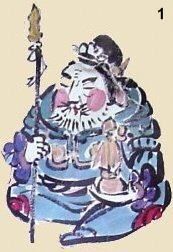 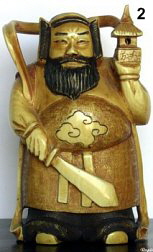 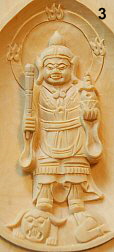 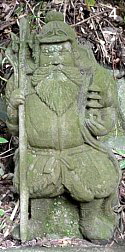
click any image to enlarge
|
- Modern poster image found at Myōryūji Temple 妙隆寺 in Kamakura. The temple also sells shikishi 色紙 with this image. Myōryūji Temple is the 7th site on the Kamakura Pilgrimage to the 7 Lucky Gods.
- Ivory Bishamonten in the collection of Andres Bernhard (Rapick) in Italy.
- Modern Bishamon amulet available for purchase at our siste site.
- Stone statue in private garden in Kamakura City, Early 20th Century.
|
|
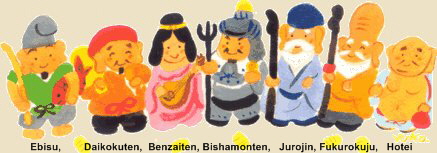
Click here for hundreds of Japanese cartoons of the Seven Lucky Gods
|
|

 BISHAMON'S MESSENGER -- THE CENTIPEDE BISHAMON'S MESSENGER -- THE CENTIPEDE
Bishamon no Tsukai 毘沙門の使 or 毘沙門の使神.
As one of Japan's Seven Lucky Gods of treasure and wealth, Bishamonten is accompanied (from around the 17th century) by a very curious messenger -- a centipede (mukade, hyakusoku 百足), a creature attributed with sniffing out gold mines in mountain deposits. Says site contributor Gabi Greve: "Centipedes are said to possess an ability to spot gold mines. Therefore Japanese people used to carry centipedes in bamboo tubes when they went to the mountains in search of gold. These messenger centipedes are different from ordinary ones. There is something glossy and noble about them, and they appear in the drawing rooms, sitting rooms, and places where Kōjin deities and water gods preside. You must not kill them by mistaking them for common centipedes. You may take their appearance for a sign of some change in your happiness and prosperity." <end Gabi Greve quote) In other Asian nations, Bishamonten (aka Kubera) is associated with a snake or a mongoose. <Flammarion>
|
|

|
KUBERA / KUVERA NOTEBOOK
|
|

 Kubera: Hindu God of Wealth. Says Meher McArthur, the curator of East Asian Art at the Pacific Asia Museum (Pasadena): "In Tibet and Nepal, Vaishravana (Jp. = Bishamonten / Tamonten) is closely related to the God of Wealth, Kubera, who is considered to be his most important manifestation. It is possible that Vaishravana is the Buddhist form of the earlier Hindu deity, Kuvera / Kubera, who was the son of an Indian sage, Vishrava, hence the name, Vaishravana. According to Hindu legend, Kubera performed austerities for a thousand years, and was rewarded for this by the greator god, Brahma, who granted him immortality and the position of God of Wealth, and guardian of the treasures of the earth. As Vaishravana, this deity also commands the army of eight Yasha (Yaksa), or demons, who are believed to be emanations of Vaishravana himself. The most important of these eight are the dark-skinned Kuvera / Kubera of the north and the white Jambala of the east. Each of these emanations holds a mongoose that spews jewels. In Tibet and Nepal, he is worshipped as the God of Wealth in all three manifestations: Vaishravana, Kubera, and Jambala." Meher also says: "In many Tibetan and Nepalese images of Kuvera/Kubera, the deity is shown as a plump figure wearing a crown, ribbons and jewelry, and holding a mongoose, representing this god's vistory over the naga (snake deities), who symbolize greed. As God of Wealth, Vaishravana/Kubera squeezes the mongoose and causes the creature to spew out jewels." <Quoted from McArthur's book "Reading Buddhist Art: An Illustrated Guide to Buddhist Signs & Symbols." ISBN 0-500-28428-8, Published 2002 by Thames & Hudson. Click here to view or buy book at Amazon. Kubera: Hindu God of Wealth. Says Meher McArthur, the curator of East Asian Art at the Pacific Asia Museum (Pasadena): "In Tibet and Nepal, Vaishravana (Jp. = Bishamonten / Tamonten) is closely related to the God of Wealth, Kubera, who is considered to be his most important manifestation. It is possible that Vaishravana is the Buddhist form of the earlier Hindu deity, Kuvera / Kubera, who was the son of an Indian sage, Vishrava, hence the name, Vaishravana. According to Hindu legend, Kubera performed austerities for a thousand years, and was rewarded for this by the greator god, Brahma, who granted him immortality and the position of God of Wealth, and guardian of the treasures of the earth. As Vaishravana, this deity also commands the army of eight Yasha (Yaksa), or demons, who are believed to be emanations of Vaishravana himself. The most important of these eight are the dark-skinned Kuvera / Kubera of the north and the white Jambala of the east. Each of these emanations holds a mongoose that spews jewels. In Tibet and Nepal, he is worshipped as the God of Wealth in all three manifestations: Vaishravana, Kubera, and Jambala." Meher also says: "In many Tibetan and Nepalese images of Kuvera/Kubera, the deity is shown as a plump figure wearing a crown, ribbons and jewelry, and holding a mongoose, representing this god's vistory over the naga (snake deities), who symbolize greed. As God of Wealth, Vaishravana/Kubera squeezes the mongoose and causes the creature to spew out jewels." <Quoted from McArthur's book "Reading Buddhist Art: An Illustrated Guide to Buddhist Signs & Symbols." ISBN 0-500-28428-8, Published 2002 by Thames & Hudson. Click here to view or buy book at Amazon.
NOTES OF CONFUSION
GREAT BLACK ONES, BLACK WARRIORS
KUBERA, BISHAMONTEN, & DAIKOKUTEN (MAHAKALA). Daikoku originates from the Hindu deity Mahakala, the "Great Black One." Mahakala in turn may have originated from another Hindu deity named Kubera (Kuvera), the latter closely associated with the color black and wealth. The situation gets even more complicated, for Tamonten (also known as Bishamonten), the chief of the Four Heavenly Kings and the guardian of the north and winter, is considered the primary Buddhist emanation of Kubera / Kuvera.
- Says Meher McArthur, the curator of East Asian Art at the Pacific Asia Museum (Pasadena): "According to the writings of a Chinese Buddhist pilgrim, images of a seated god holding a bag of gold were placed at the doorways of monasteries and were anointed with oil by worshippers. The oil turned the statues black, and so the figures were known as Mahakala, or "Great Black One." The bag of gold is an attribute of the Hindu deity Kubera, the God of Wealth, so the deity may have originated as Kubera. In Nepal, images of Mahakala closely resemble Kubera and may be one and the same deity. In Japan, Mahakala is worshipped as Daikoku or Makiakara-ten, the "Great Black One" in Esoteric Buddhism. But since the 17th century, the deity became better known as Daikoku or Daikokuten, the God of Wealth, and one of the Seven Lucky Gods (Shichifukujin)." <quoted from McArthur's book "Reading Buddhist Art: An Illustrated Guide to Buddhist Signs & Symbols." ISBN 0-500-28428-8, Published 2002 by Thames & Hudson. Click here to view or buy book at Amazon. >
- There are many similarities between Daikoku (Skt. = Mahakala, Great Black One), and Kubera (Hindu god of wealth). In Japan, Daikoku is derived from Mahakala. He is not, to my knowledge, considered a manifestation of Kubera, as some site readers have suggested. In Japan, Kubera is better known as Tamonten or Bishamonten. Kubera is the Hindu god of darkness, treasures, and wealth, and guards the north. His color is BLACK, and he is sometimes called the "Black Warrior." In India, his symbols are the flag, the jewel, and the mongoose. The Kinnara (Kimnara) are celestial musicians with human bodies and horses' heads, officiating at the court of Kubera / Kuvera. In China, Buddhist monks claim that the Taoist deity of the Kitchens, Zao Jun, is in fact a Kinnara. In India, and Hindu legends, the Kinnara are birds of paradise, and typically represented as birds with human heads playing musical instruments.
Daikoku and Kubera thus share the following associations -- the color black, the kitchen (see kitchen gods), and wealth. Yet, to my knowledge, in Japan, Daikoku is not known as Kubera. Instead, Kubera is identified with Bishamonten/Tamonten. Nevertheless, it is not impossible that some localities in Japan consider Daikoku to be a manifestation of Kubera or vice versa. However, with no concrete evidence to underpin this association, I will continue to consider Daikoku and Kubera as independent and separate deities despite their overlapping iconography. For more on Japan's various kitchen gods, click here.
- Eight Yasha Generals of Bishamonten (aka Bishamonten Yasha Hachidaishō 毘沙門天夜叉八大将). Says JAANUS: "Yasha 夜叉. Also Yakusha 薬叉 (Skt. = Yaksa). A class of semi-divine beings usually considered to be of a benevolent and inoffensive disposition but sometimes also classed with malignant spirits such as the Rasetsu 羅刹. The female counterparts are called Yashanyo 夜叉女 (Skt. = Yaksi, Yaksini) and were regarded in particular as tree nymphs or symbols of fertility. Yasha were adopted into Buddhism at an early stage, and many finely executed stone reliefs and statues are to be found at Sanchi, Mathura, and elsewhere in India. Eventually they came to be included among the eight classes of being that protect Buddhism (Hachibushū 八部衆). They also act as attendants of Bishamonten 毘沙門天, who is said to have under his command Eight Yasha Generals. The Twelve Divine Generals (Jūni Shinshou 十二神将 who protect devotees of Yakushi Buddha 薬師 and the Sixteen Good Gods (Jūroku Zenjin 十六善神) who protect the Daihannyakyō 大般若経 (Great Wisdom Sutra) also belong to the category of Yasha."
One of Bishamon's generals is Daigensui 大元帥 (aka Daigensui Myō-ō 大元帥明王). Says Clemente Beghi in the CSJR Newsletter (#16-17, Jan. 2008): "He is traditionally considered a general of demons (Jp. = kijin daishō 鬼神大将), but it is only in Śubhakarasiṃha's Ritual Manual of the Dhāraṇī Sūtra of Mareshal Āṭavika Great Commander (Jp. Atabaku-gensui-taishō-jōbutsudaranikyō-shugyō-giki 阿吒薄俱元帥大將上佛陀羅尼經修行儀軌), that the term 'marshal' (yuanshuai 元帥), the highest Chinese military title, is attributed to him." <end quote>
- Says JAANUS: "Daigensui Myō-ō大元帥明王. One of Bishamonten's eight Yasha attendants, shares many of the functions attributed to Tobatsu Bishamonten -- namely, both are protectors of the nation and invoked in ceremonies to quell foreign enemies. Daigensui is the central deity in the rite known as Daigensuihō 大元帥法, an esoteric ritual performed specifically to quell foreign invaders or internal rebellions. It was first perfomed in 840 for Emperor Ninmyō 仁明, and even today it is still performed in the year following the accession of an emperor.
- Says the Digital Dictionary of Buddhism: "Yasha 夜叉 (Chn. = Yèchā). The eight attendants of Kuvera 八大將, or Vaiśravaṇa, the god of wealth; those on earth bestow wealth, those in the empyrean houses and carriages, those in the lower heavens guard the moat and gates of the heavenly city. There is another set of sixteen. The names of all are given in the Dhāraṇī-sammucaya-sūtra 陀羅尼集經. See also rakṣa 羅刹 and kṛtya 吉遮. Yakṣa-kṛtya are credited with the powers of both yakṣa and kṛtya. Also transliterated as 乞叉; 藥叉; 閱叉." <end quote>
- Writes DE VISSER [where; must give proper citation]: "In the Bishamontennō-kyō, it states that when a practitioner recites the sutra and makes offerings to Bishamon, the deity will manifest in the form of a dōji or a layperson, according to the wish of the practitioner. See T. 21, 1244: 215-216, 216a. Furthermore, the sutra says "those who recite the sutra will obtain the ability to fly about freely." Art historians Miya Tsugio and Sawa Takaaki have suggested that the sword-gohō is the fifth servant spirit of Bishamonten, which is evident from the similarity of images of the dōji with that of this fifth servant spirit (an adult wearing a similar sword suit). Miya Tsugio, "Shigisan engi kyojitsu zakkō," in Bukkyō setsuwa-e no kenkyū, ed. Kameda Tsutomu (Tokyo: Tokyo bijitsu, 1979), pp. 129-146. For the image, see Taishō zuzōbu 7, 551; Sawa Takaaki, "Shigisan engi to Toba s?j? Kakuyu-kō," in Nihon emaki taisei 4: Shigisan engi (Tokyo: Ch??koronsha, 1977).........From this story we discover that the gohō dōji had red hair and had great strength. This gohō dōji belonged to Bishamonten's family and was a converted yaksa, thus he was a yaksa dōji. Bishamonten was served by a number of these yaksa dōji. Owing to the fact that they were converted demonic spirits, they could forget the rules and fail to exercise moderation at times, ending up inflicting cruelty and violence when they used their strength during the performance of their assigned duties. Even though they were commanded by kami, buddhas, and monks, and served them, they could kill other beings over a mistake, or in anger. Gohō were powerful, dangerous, and turbulent spirits, whose negligence or zeal was sometimes out of control in the fulfillment of an order."
|
|

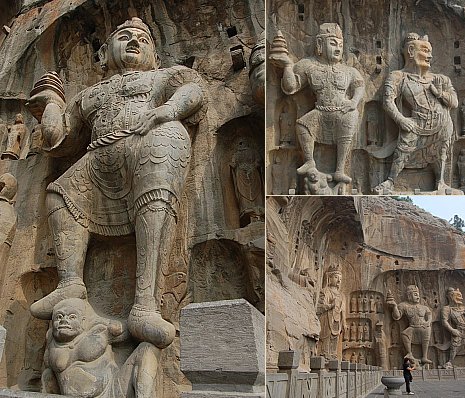
Tamonten (Bishamonten)
Fengxian Temple 奉先寺, China, Ancestor Worshipping Temple
Carving began in 672, completed circa 672-675 AD
Tamonten (aka Bishamonten), one of Four Heavenly Kings
standing atop evil creature known in Japan as Jaki.
For many more photos, see Longmen Caves of China.

PRIMARY SOURCES
- Azuma Kagami 全訳吾妻鑑, an official Japanese record of the Kamakura era describing events between 1180 and 1266, says the famed warrior Sakanoue no Tamuramarō 坂上田村麻呂 (758-811) subdued northern Japan and the Ainu people. It also says he built a temple for the deity in the conquered territory [other legends say he presented his sword to the temple as well] in gratitude for the deity's assistance in gaining victory. [What is the name of the temple?] This text also mentions that Minamoto Yoritomo 源頼朝 (1147-1199) worshipped Bishamon, as did his mortal enemy Taira no Kiyomori 平 清盛 (1118–1181). Both prayed to Bishamon for assistance in crushing their enemies in battle. The Minamoto clan eventually defeated the Taira.
- Besson Zakki 別尊雑記 (Miscellaneous Notes on Individual Deities), compiled in the late 12th to early 13th centuries. Provides illustrations of many Buddhist deities and their attributes.
- Bishamon-gyō 毘沙門經. Also called the Daijō Bishamon Kudoku kyō 大乘毘沙門功德經 or the Daijō Bishamon Kyō 大乘毘沙門經. Translated as Mahāyāna Sūtra of the Merits of Vaiśravaṇa. Japanese indigenous scripture composed sometime from the 10th to the early 12th century. Says Vaisravana is Kubera (the latter is the Hindu guardian of wealth).
- Bishamontennō no Honji 毘沙門天王之本地; this 17th-century Japanese text contains a popular story about the marriage between Bishamon and Kichijōten. For an English overview of the story, see Saroj Kumar Chaudhuri, pp 28-30
REFERENCES:
For an English description of the Bishamon-Kichijoten marriage myth, as it appears in the 17th-century Bishamon no Honji, see Hindu Gods and Goddesses in Japan. Chaudhuri, Saroj Kumar, pages 28-30. Vedams, 2003, xviii, 184 p, ISBN : 81-7936-009-1.
To read the digitized version of the Bishamon no Honji, see Tokyo University.
.
- Butsuzō-zu-i 仏像図彙, "Collected Illustrations of Buddhist Images." Published 1690 (Genroku 元禄 3). Major Japanese dictionary of Buddhist iconography. Hundreds of pages and drawings, with deities classified into approximately 80 categories. Above photos from the expanded Meiji-period (1868-1912) reprint of the standard 1783 edition, last published in 2005. The expanded version includes Japanese-language commentary by Itō Takemi 伊藤武美 (b. 1927). Purchase the Meiji-period reprint at this online J-site.
- Daijō Bishamon Kudoku Kyō. See Bishamon-gyō.
- Daijō Bishamon Kyō. See Bishamon-gyō.
- Dainichi-kyō 大日經 (Mahāvairocana Sūtra); says Vaisravana is Kubera (the guardian of wealth). One of the most important texts among Asia's Esoteric schools. Translated by Śubhakarasiṃha 善無畏 with the assistance of Yixing 一行 in 724; commonly abbreviated as Vairocanābhisaṃbodhi.
- Damamūka-nidāna Sūtra 賢愚経 (Jp. = Gengukyō). Fifth-century Chinese translation by Huìjué 慧覺 (Jp. = Ekaku). Vaisravana is signaled out among the four & described as a yaksa and their lord.
- Fusō Ryakuki 扶桑略記, a document dated to 1150 AD, contains a record of historical events up to 1094. It tells the story of Fujiwara no Isendo (Isehito ?), who is credited as one of two founders of Kurama-dera Temple 鞍馬寺, just north of Kyoto. Kurama Dera's central deity is Bishamon.
- Gengukyō 賢愚経. See Damamūka-nidāna Sūtra.
- Hokekyo 法華経 (Lotus Sutra). Translated into Chinese by Kumārajīva 鳩摩羅什 350 - 410 (Jp. = Kumarajū). Tamonten (aka Bishamonten) appears in the Dharani (26th chapter), pledging along with Jikokuten on behalf of all four to protect those who embrace the Lotus Sutra.
- Hōkō Daishōgon Kyō 方廣大莊嚴經 (Chn. = Fangguang da zhuangyan jing, Skt. = Lalitavistara). Translated by Divākara 地婆訶羅 in 683. Tells story of the four bowls miraculously merged into one.
- Keiran Shūyō Shū (溪嵐拾葉集, T2410_.76.0711c27). Text compiled in first half of 14th century by monk Kōshū 光宗. Includes stories about Bishamon, including story of Tobatsu Bishamon.
- Kirin Ongi 希麟音義 (Chn. = Xīlín yīnyì) or Zoku-issai-kyō-ongi 続一切經音義. Tang-era work of Buddhist expressions, compiled by Xīlín Yīnyì 希麟音義 in the Tang dynsaty. Says Vaisravana has lots of treasures. Listed in Taishō (T 2129).
- Konjaku Monogatari 今昔物語, a collection of tales from India, China, and Japan written during the late Heian Period (794 -1192 AD). It includes a story about the establishment of Kuramadera Temple by Fujiwara no Isendo, a story of how Bishamon granted a child to a poor monk, and others. See Marian Ury's translation, Tales of Times Now Past. Sixty-Two Stories from a Medieval Japanese Collection. University of California Press, 1979, pages 117-120.
- Konkōmyō-kyō 金光明経. The 5th-century Golden Light Sutra (Skt. = Suvarṇa-prabhāsôttama) has a chapter called the Shitennō-bon, first translated by monk Donmusen 曇無讖 (Skt. = Dharmaraksana, Dharmakṣema, 385-433) between 414 & 426. It describes the four as protectors of the world; became one of Japan's most important early scriptures, especially for protecting the state.
- Mahabharata,
REFERENCES:
Japanese Folklore Involving Bishamonten Borrows from the Vedic Mahabharata.
According to Vedic Connections Online Knowledge Center:
The Mahabharata is one of the two major Sanskrit epics of ancient India, the other being the R?m?ya?a. The below is a Japanese version of a story appearing in the Mahabharata:
King Sibi is believed to be a previous incarnation of Sakyamuni Buddha. In this story a heavenly being named Bishamon (Kuvera) approaches the god Taishaku (Indra) and tells him, 'There is a great Bodhisattva named King Sibi. Soon he will become a Buddha.' On hearing this Taishaku decides to test the sincerity of the King's practice in pursuing enlightenment. He transforms himself into a hawk and instructs Bishamon to take on the appearance of a dove.
Chased after by the hawk, the dove escapes and flies into the arms of King Sibi. Perched on the branch of a tree, the hawk says to the King, "Please let me have the dove back. It is what I have been trying to get." King Sibi replies, "No, I can't because I have vowed to protect all living things. I cannot return it to you."
The hawk then points out, "I am one of the living things that you have vowed to save. If you take away my food for today, I will be unable to live tomorrow."
The King then offers to cut off a piece of his own flesh and gave it to the hawk. As the King proceeded to cut his own flesh, the hawk measures it using a balance and found the dove to be consistently heavier than the muscle of the King. No matter how much muscle was added, the weight was lighter than the total weight of the dove. Finally, the King cuts all the flesh off of his body.
The King tries desperately to put his entire body on the balance, but falls to the ground. He then exclaims, "I once made a pledge to save all living beings! I cannot let such minor sufferings defeat me!"
At last he successfully climbs onto the balance. Watching the entire scene, all the heavenly beings praise the King saying, "He did not begrudge his life, even for a bird. He is a person who best suits the title of Bodhisattva."
Suddenly, Taishaku casts off his disguised figure as a hawk and regains his original appearance. He says to the King, "Don't you have any pain or regret?" The King replies, "I have no regrets whatsoever. My heart is rather full of joy."
No sooner did the King utter these words than did his body change back into what it used to be. one of two major Sanskrit epics of old India. Click link for story transmitted to Japan.
- Mahāmāyūrī-Sūtra, 孔雀明王經. Sūtra of the Great Peacock, Queen of Mantras (sign in with user name = guest). Translated by Hsüan Tsang 玄奘 (Jp. = Genjō, 600–664). The Sanskrit version of this sutra says Vaisravana is the protector of the people of Tokhara, the region around the Oxus river basin. Says Chaudhuri, pages 23: "The account of Khotan by Hsüan says the king (at that time) claimed to be a descendent of Vaisravana. One of his childless ancestors had prayed to Vaisravana for a son, and Vaisravana subsequently produced a child from his head for the childless king. All these tend to show that the cult of Vaisravana basically arose in this region. The reference to Vaisravana as the guardian of the north is very significant. Seen from India, the Oxus region is indeed located to the north. The possibility of this cult of Vaisravana traveling south to India from Khotan with the conquering Kushans cannot be ruled out. In India, he was associated with Kubera. The cult also traveled east to China with Buddhist monks."
- Mochizuki Shinkō, Bukkyō Daijiten [MZ] gives individual listings for the 28 Attendants of Senju Kannon, and the Four Heavenly Kings are said to have the same provision of demons, known as 鬼神衆. [NOTE: 4 X 7 Matrix = 28.]
- Shigisan Engi Emaki 信貴山縁起絵巻 (Illustrated Handscroll of the Legends of Mt. Shigi). This late Heian-era text includes tales of Bishamon's miraculous powers.
- Shoku Nihongi 続日本紀, 2nd official history of Japan, compiled 797. Chaudhuri says this text contains a passage about a relic miraculously appearing from the body of a Vaisravana idol at Sumidera Temple, which was then paraded about the city; a temple dedicated to Vaisravana was built shortly afterword north of Kyoto. However, I cannot find this reference in the Shoku Nihongi. [need to confirm]
- Uji Shūi Monogatari. A collection of folk tales compiled between 1212 and 1221, which depicts Bishamonten as a god of fortune.
- Zoku-issai-kyō-ongi 続一切経音義. See Kirin Ongi.
SECONDARY SOURCES
- A History of Japanese Religion. Edited by Kazuo Kasahara. Kosei Publishing Company, 2001. Translated by Paul McCarthy and Gaynor Sekimori. 648 pages. Sixteen distinguished experts on Japanese religion approach the topic from modern perspectives. Topics range from prehistoric times up until the early postwar years.
- Buddhism (Flammarion Iconographic Guides)
 , by Louis Frederic, Printed in France, ISBN 2-08013-558-9, First published 1995. A highly illustrated volume, with special significance to those studying Japanese Buddhist iconography. Includes many of the myths and legends of mainland Asia as well, but its special strength is in its coverage of the Japanese tradition. Hundreds of accompanying images/photos, both B&W and color. , by Louis Frederic, Printed in France, ISBN 2-08013-558-9, First published 1995. A highly illustrated volume, with special significance to those studying Japanese Buddhist iconography. Includes many of the myths and legends of mainland Asia as well, but its special strength is in its coverage of the Japanese tradition. Hundreds of accompanying images/photos, both B&W and color.
- Chaudhuri, Saroj Kumar, pages 20-35. Hindu Gods and Goddesses in Japan. Vedams, 2003, xviii, 184 p, ISBN : 81-7936-009-1. See partial preview of book at Google Online Book Preview.
- Digital Dictionary of Chinese Buddhism (C. Muller; login "guest")
- Essentials of Buddhist Images: A Comprehensive Guide to Sculpture, Painting, and Symbolism. By Kodo Matsunami. Paperback; first English edition March 2005; pages 126-127. Published by Omega-Com. Says Matsunami: "Bishamonten protects from disaster and bodily harm. Daikoku satisfies the desire for food. Benzaiten represents sexual desire. Hotei brings laughter, and Ebisu grants wealth." Pages 126-127.
- Granoff, Phyllis. Tobatsu Bishamon: Three Statues in American Museums and the Rise of this Cult in East Asia, East and West, 1970, vol.20, nos 1-2, pp. 144-168.
- Greve, Gabi. See her online Bishamonten page. Says Gabi: "Bishamonten helps those born on the day of the tiger, in the hour of the tiger and in the year of the tiger. He is especially venerated with tiger amulets at Mount Shigisan and Mount Kurama." On her First Day of the Tiger (hatsu tora 初寅) page, she writes: "The Tiger hour is about 3-5 am, Tiger Month is January, and Tiger day comes up every 12 days." <Editor's note. In the Zodiac Calendar, the tiger is associated with the NORTHEAST, which is considered the most dangerous of all directions and linked to the Chinese term Guǐmén 鬼門 (Jpn. = Kimon), literally "demon gate" or "gate of devils," an important concept from Chinese geomancy 風水 (Chn. = fēngshuǐ, Jpn. = fusui). In Chinese thought, the northeast quarter is the place where "demons gather and enter." Since it is the most inauspicious of all directions, it is guarded by the greatest and strongest directional protector -- Bishamon -- who also serves as the commander of the Shitennō (Guardians of the Four Compass Directions). In addition, the Tiger is one of four Chinese creatures (Sì Shòu 四獸; the Four Celestial Emblems), each guarding one of the four cardinal directions. In this capacity, the animal is known as Byakko 白虎 (Chn = Baihu), the WHITE TIGER, one who guards Buddha's teachings (as does Bishamonten). In Japan, however, this grouping of four animals has been largely supplanted by the Shitennō. As one of the four celestial emblems, the WHITE TIGER is associated with WEST and the element metal (see Five Elements). Let us recall that Bishamonten is the guardian of earth's treasures, which are found in deposits of gold, silver and other metals. Given the above associations, the link between the Tiger and Bishamonten is most appropriate.
- Handbook on Viewing Buddhist Statues 仏像の見方ハンドブック. By Ishii Ayako. A wonderful book. Published 1998. Japanese Language. 192 pages; 80 or so color photos. ISBN 4-262-15695-8.
- JAANUS. Japanese Architecture and Art Net Users System. A wonderful online dictionary compiled by the late Dr. Mary Neighbour Parent. It covers both Buddhist and Shinto deities in great detail. Over 8,000 entries. Written in English, yet presenting all key terms in Japanese. See Bishamonten page or Tobatsu Bishamonten page.
- Linrothe, Robert. Ruthless Compassion: Wrathful Deities in Early Indo-Tibetan Esoteric Buddhist Art. Serindia Publications, Inc., 1999. On page 10: "Vaisravana, in the form of Kubera, was the focus of a cult in India, Central Asia, China, and Japan. In the latter he was known as Tobatsu Bishamonten."
- Mori, Hisahi, Sculpture of the Kamakura Period, Published 1974. A book close to my heart, this publication devotes much time to the artists who created the sculptural treasures of the Kamakura era, including Unkei, Tankei, Kokei, Kaikei, and many more.
- Reading Buddhist Art: An Illustrated Guide to Buddhist Signs & Symbols. By Meher McArthur. ISBN 0-500-28428-8, Published 2002 by Thames & Hudson. Click here to view or buy book at Amazon. <McArthur is curator of East Asian Art at the Pacific Asia Museum (Pasadena)>
- The Seven Lucky Gods of Japan
 , by Chiba Reiko. Charles E. Tuttle Co., 1966. Also see UCLA Center for East Asian Studies, Educational Resources from teacher Samantha Wohl, Palms Middle School, Summer 2000. See Wohl's Materials List (based on Chiba Reiko's book). , by Chiba Reiko. Charles E. Tuttle Co., 1966. Also see UCLA Center for East Asian Studies, Educational Resources from teacher Samantha Wohl, Palms Middle School, Summer 2000. See Wohl's Materials List (based on Chiba Reiko's book).
- Ruppert, Brian D. Jewel in the Ashes: Buddha Relics and Power in Early Medieval Japan. Harvard University Asia Center (July 1, 2000). ISBN-10: 0674002458. Focuses on relic worship in medieval Japan. Copious reference notes, this work is aimed at scholars. It includes a very useful glossary of terms. Highly recommended. Says scholar Ruppert of Harvard University: "Bishamonten 毘沙門 (天); also known as 吠室羅未拏 Beishiramana [bana, banu], 毘舎羅門 Bisharamon, 多聞 Tamon, 倶吠羅 Kubeira, 金毘羅 Konpira, and 拘毘羅毘沙門 Kubira Bishamon.
- Sasaki Kōzō, On a Problem of Tobatsu Bishamonten, Bijutsushi, Journal of the Japan Art History Society, Vol. 10, No. 2, November 1960.
- Secke, Dietrich. Buddhist Temple Names in Japan. Monumenta Nipponica, Vol. 40, No. 4 (Winter, 1985), pp. 359-386, Published by Sophia University. Secke says many Japanese temples are named after the various deities. For example, he writes: "Deva (ten 天). Shitennōji 四天王寺 (in shortened form, Tennōji) is called after the Four Devarājas governing and protecting the four quarters of the universe. Of the individual gods we find only Vaiśravaṇa, King of the North and bestower of riches, in Bishamon-dō 毘沙門堂 (transliterating his Sanskrit name), while Tamonji/-in 多聞寺/院 is a hybrid of phonetic rendering (-vana> mon) and semantic interpretation using the explanatory character 聞, for mon."
- Soothill (William Edward) & Hodous (Lewis). A Dictionary of Chinese Buddhist Terms. With Sanskrit & English Equivalents. Plus Sanskrit-Pali Index. Hardcover, 530 pages. Published by Munshirm Manoharlal. Reprinted March 31, 2005. ISBN 8121511453.
- Tobifudo Deity Dictionary. Ryūkozan Shōbō-in Temple 龍光山正寶院 (Tokyo). Tendai Sect. The following pages were useful: Bishamon//Tobatsu Bishamon//Tamonten//7 Lucky Gods
- Tokyo University https://www.um.u-tokyo.ac.jp/publish_db/1994collection1/
PHOTOS / IMAGES / CLIPART
- Sanskrit images used with permission from this J-site.
- Tamonten, 13th century, Nara National Museum; also see various views of this statue
- Tobatsu Bishamonten, Oldest Extant Statue, Various Views, Nara National Museum
- Tobatsu Bishamonten, Besson Zaki, Others (J-site)
- Tobatsu Bishamonten Drawing, 10th Century, Tokyo University
- Toji Temple's own photos of Tobatsu Bishamon
- Art and Archaeology, Four Heavenly Kings at Toji Temple
- Narushima Tobatsu Bishamon and Demons (J-site) and another page from same site
- MFA Boston, Bishamon Prints, Menu Page, also Tamonten painting
- Overview of Armor, Jaki, Robes, Footwear (J-site)
- Nippon Foundation Library 日本財団図書館
- Jiten Closeup, Todaiji Temple (Nara); also see this J-site; also this J-site, and this one.
- 12 Deva (Image, Siebold) at the Digital Archive
- Cultural Heritage Online, Bishamon Images, J-site
- Bishamon and other status by Unkei (J-site)
- Atago Jinja, Tobatsu Bishomon, Other Topics
- Bishamon stone carvings in Okayama Prefecture (J-site) 毘沙門天磨崖仏
石槌山毘沙門天磨崖仏 // 庚申山毘沙門天磨崖仏 // 鷲峰山毘沙門天磨崖仏
LEARN MORE
|
|